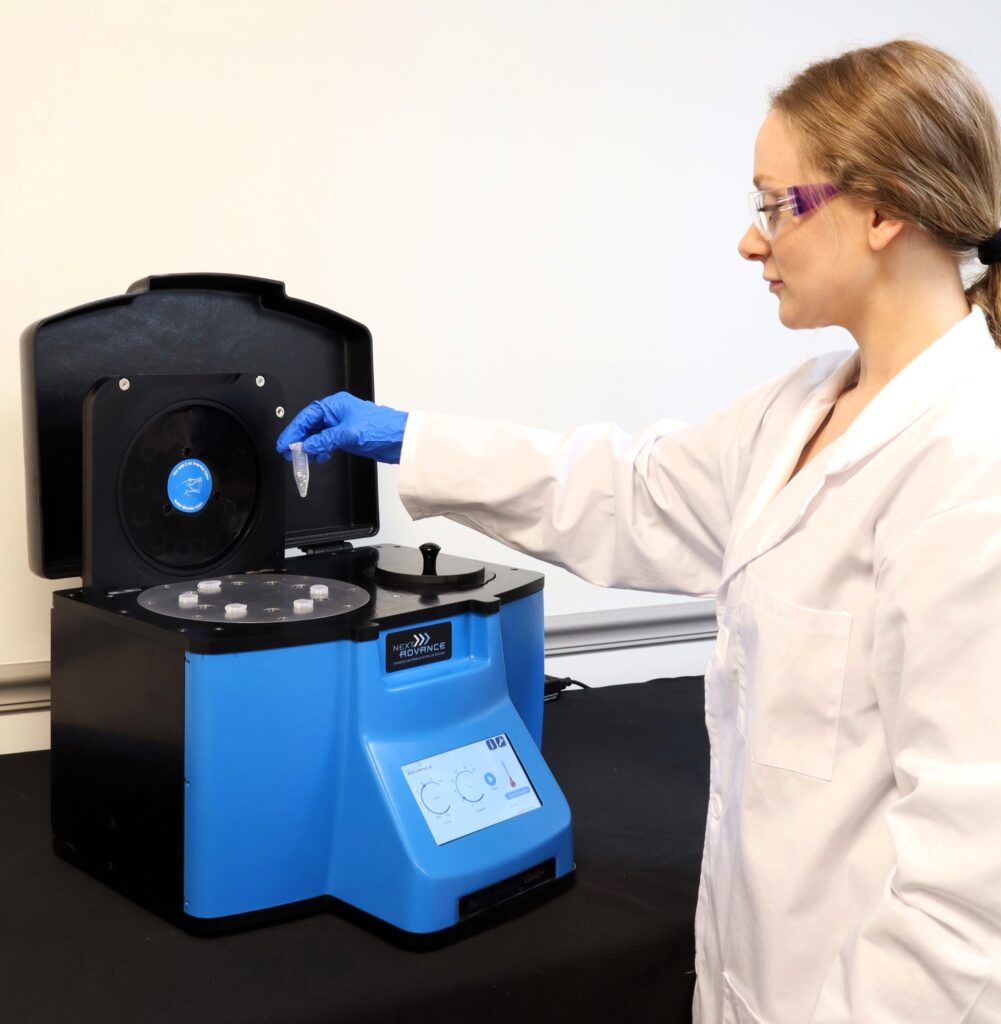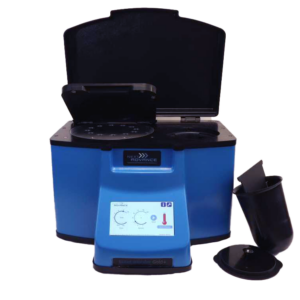Ideal for Skin Tissue Homogenization
Do you spend lots of time and effort homogenizing skin tissue samples? The Bullet Blender® tissue homogenizer delivers high quality and superior yields. No other homogenizer comes close to delivering the Bullet Blender’s winning combination of top-quality performance and budget-friendly affordability. See below for a skin tissue homogenization protocol.
Save Time, Effort and Get Superior Results with
The Bullet Blender Homogenizer
Consistent and High Yield Results
Run up to 24 samples at the same time under microprocessor-controlled conditions, ensuring experimental reproducibility and high yield. Process samples from 10mg or less up to 3.5g.No Cross Contamination
No part of the Bullet Blender ever touches the tissue – the sample tubes are kept closed during homogenization. There are no probes to clean between samples.Samples Stay Cool
The Bullet Blenders’ innovative and elegant design provides convective cooling of the samples, so they do not heat up more than several degrees. In fact, our Gold+ models hold the sample temperature to about 4ºC.Easy and Convenient to Use
Just place beads and buffer along with your tissue sample in standard tubes, load tubes directly in the Bullet Blender, select time and speed, and press start.Risk Free Purchase
Thousands of peer-reviewed journal articles attest to the consistency and quality of the Bullet Blender homogenizer. We offer a 2 year warranty, extendable to 4 years, because our Bullet Blenders are reliable and last for many years.Skin Tissue Homogenization Protocol
Sample size |
See the Protocol |
| microcentrifuge tube model (up to 300 mg) | Small skin samples |
| 5mL tube model (100mg - 1g) | Medium skin samples |
What Else Can You Homogenize? Tough or Soft, No Problem!
The Bullet Blender can process a wide range of samples including organ tissue, cell culture, plant tissue, and small organisms. You can homogenize samples as tough as mouse femur or for gentle applications such as tissue dissociation or organelle isolation.



Skin tissue pieces (on beads in upper photo) are completely homogenized into the buffer (slightly darker in lower photo).
Want more guidance? Need a quote? Contact us:

Bullet Blender Models
Select Publications using the Bullet Blender to Homogenize Skin Tissue
2474232
skin
1
apa
50
date
desc
3257
https://www.nextadvance.com/wp-content/plugins/zotpress/
%7B%22status%22%3A%22success%22%2C%22updateneeded%22%3Afalse%2C%22instance%22%3Afalse%2C%22meta%22%3A%7B%22request_last%22%3A0%2C%22request_next%22%3A0%2C%22used_cache%22%3Atrue%7D%2C%22data%22%3A%5B%7B%22key%22%3A%22H74B9E55%22%2C%22library%22%3A%7B%22id%22%3A2474232%7D%2C%22meta%22%3A%7B%22creatorSummary%22%3A%22Wen%20et%20al.%22%2C%22parsedDate%22%3A%222016%22%2C%22numChildren%22%3A2%7D%2C%22bib%22%3A%22%3Cdiv%20class%3D%5C%22csl-bib-body%5C%22%20style%3D%5C%22line-height%3A%202%3B%20padding-left%3A%201em%3B%20text-indent%3A-1em%3B%5C%22%3E%5Cn%20%20%3Cdiv%20class%3D%5C%22csl-entry%5C%22%3EWen%2C%20L.%2C%20Gao%2C%20Q.%2C%20Ma%2C%20C.%2C%20Ge%2C%20Y.%2C%20You%2C%20L.%2C%20Liu%2C%20R.%20H.%2C%20Fu%2C%20X.%2C%20%26amp%3B%20Liu%2C%20D.%20%282016%29.%20Effect%20of%20polysaccharides%20from%20Tremella%20fuciformis%20on%20UV-induced%20photoaging.%20%3Ci%3EJournal%20of%20Functional%20Foods%3C%5C%2Fi%3E%2C%20%3Ci%3E20%3C%5C%2Fi%3E%2C%20400%26%23x2013%3B410.%20%3Ca%20class%3D%27zp-DOIURL%27%20href%3D%27https%3A%5C%2F%5C%2Fdoi.org%5C%2F10.1016%5C%2Fj.jff.2015.11.014%27%3Ehttps%3A%5C%2F%5C%2Fdoi.org%5C%2F10.1016%5C%2Fj.jff.2015.11.014%3C%5C%2Fa%3E%3C%5C%2Fdiv%3E%5Cn%3C%5C%2Fdiv%3E%22%2C%22data%22%3A%7B%22itemType%22%3A%22journalArticle%22%2C%22title%22%3A%22Effect%20of%20polysaccharides%20from%20Tremella%20fuciformis%20on%20UV-induced%20photoaging%22%2C%22creators%22%3A%5B%7B%22creatorType%22%3A%22author%22%2C%22firstName%22%3A%22Lingrong%22%2C%22lastName%22%3A%22Wen%22%7D%2C%7B%22creatorType%22%3A%22author%22%2C%22firstName%22%3A%22Qing%22%2C%22lastName%22%3A%22Gao%22%7D%2C%7B%22creatorType%22%3A%22author%22%2C%22firstName%22%3A%22Chung-wah%22%2C%22lastName%22%3A%22Ma%22%7D%2C%7B%22creatorType%22%3A%22author%22%2C%22firstName%22%3A%22Yazhong%22%2C%22lastName%22%3A%22Ge%22%7D%2C%7B%22creatorType%22%3A%22author%22%2C%22firstName%22%3A%22Lijun%22%2C%22lastName%22%3A%22You%22%7D%2C%7B%22creatorType%22%3A%22author%22%2C%22firstName%22%3A%22Rui%20Hai%22%2C%22lastName%22%3A%22Liu%22%7D%2C%7B%22creatorType%22%3A%22author%22%2C%22firstName%22%3A%22Xiong%22%2C%22lastName%22%3A%22Fu%22%7D%2C%7B%22creatorType%22%3A%22author%22%2C%22firstName%22%3A%22Dong%22%2C%22lastName%22%3A%22Liu%22%7D%5D%2C%22abstractNote%22%3A%22%22%2C%22date%22%3A%2201%5C%2F2016%22%2C%22language%22%3A%22en%22%2C%22DOI%22%3A%2210.1016%5C%2Fj.jff.2015.11.014%22%2C%22ISSN%22%3A%2217564646%22%2C%22url%22%3A%22http%3A%5C%2F%5C%2Flinkinghub.elsevier.com%5C%2Fretrieve%5C%2Fpii%5C%2FS175646461500554X%22%2C%22collections%22%3A%5B%22M2MNG549%22%5D%2C%22dateModified%22%3A%222016-06-24T16%3A32%3A44Z%22%7D%7D%2C%7B%22key%22%3A%22EUVQTK9R%22%2C%22library%22%3A%7B%22id%22%3A2474232%7D%2C%22meta%22%3A%7B%22creatorSummary%22%3A%22Falendysz%20et%20al.%22%2C%22parsedDate%22%3A%222015-10-30%22%2C%22numChildren%22%3A0%7D%2C%22bib%22%3A%22%3Cdiv%20class%3D%5C%22csl-bib-body%5C%22%20style%3D%5C%22line-height%3A%202%3B%20padding-left%3A%201em%3B%20text-indent%3A-1em%3B%5C%22%3E%5Cn%20%20%3Cdiv%20class%3D%5C%22csl-entry%5C%22%3EFalendysz%2C%20E.%20A.%2C%20Lopera%2C%20J.%20G.%2C%20Lorenzsonn%2C%20F.%2C%20Salzer%2C%20J.%20S.%2C%20Hutson%2C%20C.%20L.%2C%20Doty%2C%20J.%2C%20Gallardo-Romero%2C%20N.%2C%20Carroll%2C%20D.%20S.%2C%20Osorio%2C%20J.%20E.%2C%20%26amp%3B%20Rocke%2C%20T.%20E.%20%282015%29.%20Further%20Assessment%20of%20Monkeypox%20Virus%20Infection%20in%20Gambian%20Pouched%20Rats%20%28Cricetomys%20gambianus%29%20Using%20In%20Vivo%20Bioluminescent%20Imaging.%20%3Ci%3EPLOS%20Neglected%20Tropical%20Diseases%3C%5C%2Fi%3E%2C%20%3Ci%3E9%3C%5C%2Fi%3E%2810%29%2C%20e0004130.%20%3Ca%20class%3D%27zp-DOIURL%27%20href%3D%27https%3A%5C%2F%5C%2Fdoi.org%5C%2F10.1371%5C%2Fjournal.pntd.0004130%27%3Ehttps%3A%5C%2F%5C%2Fdoi.org%5C%2F10.1371%5C%2Fjournal.pntd.0004130%3C%5C%2Fa%3E%3C%5C%2Fdiv%3E%5Cn%3C%5C%2Fdiv%3E%22%2C%22data%22%3A%7B%22itemType%22%3A%22journalArticle%22%2C%22title%22%3A%22Further%20Assessment%20of%20Monkeypox%20Virus%20Infection%20in%20Gambian%20Pouched%20Rats%20%28Cricetomys%20gambianus%29%20Using%20In%20Vivo%20Bioluminescent%20Imaging%22%2C%22creators%22%3A%5B%7B%22creatorType%22%3A%22author%22%2C%22firstName%22%3A%22Elizabeth%20A.%22%2C%22lastName%22%3A%22Falendysz%22%7D%2C%7B%22creatorType%22%3A%22author%22%2C%22firstName%22%3A%22Juan%20G.%22%2C%22lastName%22%3A%22Lopera%22%7D%2C%7B%22creatorType%22%3A%22author%22%2C%22firstName%22%3A%22Faye%22%2C%22lastName%22%3A%22Lorenzsonn%22%7D%2C%7B%22creatorType%22%3A%22author%22%2C%22firstName%22%3A%22Johanna%20S.%22%2C%22lastName%22%3A%22Salzer%22%7D%2C%7B%22creatorType%22%3A%22author%22%2C%22firstName%22%3A%22Christina%20L.%22%2C%22lastName%22%3A%22Hutson%22%7D%2C%7B%22creatorType%22%3A%22author%22%2C%22firstName%22%3A%22Jeffrey%22%2C%22lastName%22%3A%22Doty%22%7D%2C%7B%22creatorType%22%3A%22author%22%2C%22firstName%22%3A%22Nadia%22%2C%22lastName%22%3A%22Gallardo-Romero%22%7D%2C%7B%22creatorType%22%3A%22author%22%2C%22firstName%22%3A%22Darin%20S.%22%2C%22lastName%22%3A%22Carroll%22%7D%2C%7B%22creatorType%22%3A%22author%22%2C%22firstName%22%3A%22Jorge%20E.%22%2C%22lastName%22%3A%22Osorio%22%7D%2C%7B%22creatorType%22%3A%22author%22%2C%22firstName%22%3A%22Tonie%20E.%22%2C%22lastName%22%3A%22Rocke%22%7D%2C%7B%22creatorType%22%3A%22editor%22%2C%22firstName%22%3A%22A.%20Desiree%22%2C%22lastName%22%3A%22LaBeaud%22%7D%5D%2C%22abstractNote%22%3A%22%22%2C%22date%22%3A%222015-10-30%22%2C%22language%22%3A%22en%22%2C%22DOI%22%3A%2210.1371%5C%2Fjournal.pntd.0004130%22%2C%22ISSN%22%3A%221935-2735%22%2C%22url%22%3A%22http%3A%5C%2F%5C%2Fdx.plos.org%5C%2F10.1371%5C%2Fjournal.pntd.0004130%22%2C%22collections%22%3A%5B%22M2MNG549%22%5D%2C%22dateModified%22%3A%222015-12-31T20%3A36%3A31Z%22%7D%7D%2C%7B%22key%22%3A%2245G8GEDD%22%2C%22library%22%3A%7B%22id%22%3A2474232%7D%2C%22meta%22%3A%7B%22creatorSummary%22%3A%22Kuo%20et%20al.%22%2C%22parsedDate%22%3A%222015-09-14%22%2C%22numChildren%22%3A0%7D%2C%22bib%22%3A%22%3Cdiv%20class%3D%5C%22csl-bib-body%5C%22%20style%3D%5C%22line-height%3A%202%3B%20padding-left%3A%201em%3B%20text-indent%3A-1em%3B%5C%22%3E%5Cn%20%20%3Cdiv%20class%3D%5C%22csl-entry%5C%22%3EKuo%2C%20Y.-H.%2C%20Chen%2C%20C.-W.%2C%20Chu%2C%20Y.%2C%20Lin%2C%20P.%2C%20%26amp%3B%20Chiang%2C%20H.-M.%20%282015%29.%20In%20Vitro%20and%20In%20Vivo%20Studies%20on%20Protective%20Action%20of%20N-Phenethyl%20Caffeamide%20against%20Photodamage%20of%20Skin.%20%3Ci%3EPLOS%20ONE%3C%5C%2Fi%3E%2C%20%3Ci%3E10%3C%5C%2Fi%3E%289%29%2C%20e0136777.%20%3Ca%20class%3D%27zp-DOIURL%27%20href%3D%27https%3A%5C%2F%5C%2Fdoi.org%5C%2F10.1371%5C%2Fjournal.pone.0136777%27%3Ehttps%3A%5C%2F%5C%2Fdoi.org%5C%2F10.1371%5C%2Fjournal.pone.0136777%3C%5C%2Fa%3E%3C%5C%2Fdiv%3E%5Cn%3C%5C%2Fdiv%3E%22%2C%22data%22%3A%7B%22itemType%22%3A%22journalArticle%22%2C%22title%22%3A%22In%20Vitro%20and%20In%20Vivo%20Studies%20on%20Protective%20Action%20of%20N-Phenethyl%20Caffeamide%20against%20Photodamage%20of%20Skin%22%2C%22creators%22%3A%5B%7B%22creatorType%22%3A%22author%22%2C%22firstName%22%3A%22Yueh-Hsiung%22%2C%22lastName%22%3A%22Kuo%22%7D%2C%7B%22creatorType%22%3A%22author%22%2C%22firstName%22%3A%22Chien-Wen%22%2C%22lastName%22%3A%22Chen%22%7D%2C%7B%22creatorType%22%3A%22author%22%2C%22firstName%22%3A%22Yin%22%2C%22lastName%22%3A%22Chu%22%7D%2C%7B%22creatorType%22%3A%22author%22%2C%22firstName%22%3A%22Ping%22%2C%22lastName%22%3A%22Lin%22%7D%2C%7B%22creatorType%22%3A%22author%22%2C%22firstName%22%3A%22Hsiu-Mei%22%2C%22lastName%22%3A%22Chiang%22%7D%2C%7B%22creatorType%22%3A%22editor%22%2C%22firstName%22%3A%22Andrzej%20T%22%2C%22lastName%22%3A%22Slominski%22%7D%5D%2C%22abstractNote%22%3A%22%22%2C%22date%22%3A%222015-9-14%22%2C%22language%22%3A%22en%22%2C%22DOI%22%3A%2210.1371%5C%2Fjournal.pone.0136777%22%2C%22ISSN%22%3A%221932-6203%22%2C%22url%22%3A%22http%3A%5C%2F%5C%2Fdx.plos.org%5C%2F10.1371%5C%2Fjournal.pone.0136777%22%2C%22collections%22%3A%5B%22M2MNG549%22%5D%2C%22dateModified%22%3A%222015-12-30T17%3A17%3A35Z%22%7D%7D%2C%7B%22key%22%3A%22NE7SWIU4%22%2C%22library%22%3A%7B%22id%22%3A2474232%7D%2C%22meta%22%3A%7B%22creatorSummary%22%3A%22Danan-Gotthold%20et%20al.%22%2C%22parsedDate%22%3A%222015-05-26%22%2C%22numChildren%22%3A0%7D%2C%22bib%22%3A%22%3Cdiv%20class%3D%5C%22csl-bib-body%5C%22%20style%3D%5C%22line-height%3A%202%3B%20padding-left%3A%201em%3B%20text-indent%3A-1em%3B%5C%22%3E%5Cn%20%20%3Cdiv%20class%3D%5C%22csl-entry%5C%22%3EDanan-Gotthold%2C%20M.%2C%20Golan-Gerstl%2C%20R.%2C%20Eisenberg%2C%20E.%2C%20Meir%2C%20K.%2C%20Karni%2C%20R.%2C%20%26amp%3B%20Levanon%2C%20E.%20Y.%20%282015%29.%20Identification%20of%20recurrent%20regulated%20alternative%20splicing%20events%20across%20human%20solid%20tumors.%20%3Ci%3ENucleic%20Acids%20Research%3C%5C%2Fi%3E%2C%20%3Ci%3E43%3C%5C%2Fi%3E%2810%29%2C%205130%26%23x2013%3B5144.%20%3Ca%20class%3D%27zp-DOIURL%27%20href%3D%27https%3A%5C%2F%5C%2Fdoi.org%5C%2F10.1093%5C%2Fnar%5C%2Fgkv210%27%3Ehttps%3A%5C%2F%5C%2Fdoi.org%5C%2F10.1093%5C%2Fnar%5C%2Fgkv210%3C%5C%2Fa%3E%3C%5C%2Fdiv%3E%5Cn%3C%5C%2Fdiv%3E%22%2C%22data%22%3A%7B%22itemType%22%3A%22journalArticle%22%2C%22title%22%3A%22Identification%20of%20recurrent%20regulated%20alternative%20splicing%20events%20across%20human%20solid%20tumors%22%2C%22creators%22%3A%5B%7B%22creatorType%22%3A%22author%22%2C%22firstName%22%3A%22M.%22%2C%22lastName%22%3A%22Danan-Gotthold%22%7D%2C%7B%22creatorType%22%3A%22author%22%2C%22firstName%22%3A%22R.%22%2C%22lastName%22%3A%22Golan-Gerstl%22%7D%2C%7B%22creatorType%22%3A%22author%22%2C%22firstName%22%3A%22E.%22%2C%22lastName%22%3A%22Eisenberg%22%7D%2C%7B%22creatorType%22%3A%22author%22%2C%22firstName%22%3A%22K.%22%2C%22lastName%22%3A%22Meir%22%7D%2C%7B%22creatorType%22%3A%22author%22%2C%22firstName%22%3A%22R.%22%2C%22lastName%22%3A%22Karni%22%7D%2C%7B%22creatorType%22%3A%22author%22%2C%22firstName%22%3A%22E.%20Y.%22%2C%22lastName%22%3A%22Levanon%22%7D%5D%2C%22abstractNote%22%3A%22%22%2C%22date%22%3A%222015-05-26%22%2C%22language%22%3A%22en%22%2C%22DOI%22%3A%2210.1093%5C%2Fnar%5C%2Fgkv210%22%2C%22ISSN%22%3A%220305-1048%2C%201362-4962%22%2C%22url%22%3A%22http%3A%5C%2F%5C%2Fnar.oxfordjournals.org%5C%2Flookup%5C%2Fdoi%5C%2F10.1093%5C%2Fnar%5C%2Fgkv210%22%2C%22collections%22%3A%5B%22M2MNG549%22%5D%2C%22dateModified%22%3A%222015-08-19T17%3A20%3A16Z%22%7D%7D%2C%7B%22key%22%3A%226T98SHAS%22%2C%22library%22%3A%7B%22id%22%3A2474232%7D%2C%22meta%22%3A%7B%22creatorSummary%22%3A%22Dao%20et%20al.%22%2C%22parsedDate%22%3A%222015-05-01%22%2C%22numChildren%22%3A0%7D%2C%22bib%22%3A%22%3Cdiv%20class%3D%5C%22csl-bib-body%5C%22%20style%3D%5C%22line-height%3A%202%3B%20padding-left%3A%201em%3B%20text-indent%3A-1em%3B%5C%22%3E%5Cn%20%20%3Cdiv%20class%3D%5C%22csl-entry%5C%22%3EDao%2C%20V.%2C%20Pandeswara%2C%20S.%2C%20Liu%2C%20Y.%2C%20Hurez%2C%20V.%2C%20Dodds%2C%20S.%2C%20Callaway%2C%20D.%2C%20Liu%2C%20A.%2C%20Hasty%2C%20P.%2C%20Sharp%2C%20Z.%20D.%2C%20%26amp%3B%20Curiel%2C%20T.%20J.%20%282015%29.%20Prevention%20of%20Carcinogen%20and%20Inflammation-Induced%20Dermal%20Cancer%20by%20Oral%20Rapamycin%20Includes%20Reducing%20Genetic%20Damage.%20%3Ci%3ECancer%20Prevention%20Research%3C%5C%2Fi%3E%2C%20%3Ci%3E8%3C%5C%2Fi%3E%285%29%2C%20400%26%23x2013%3B409.%20%3Ca%20class%3D%27zp-DOIURL%27%20href%3D%27https%3A%5C%2F%5C%2Fdoi.org%5C%2F10.1158%5C%2F1940-6207.CAPR-14-0313-T%27%3Ehttps%3A%5C%2F%5C%2Fdoi.org%5C%2F10.1158%5C%2F1940-6207.CAPR-14-0313-T%3C%5C%2Fa%3E%3C%5C%2Fdiv%3E%5Cn%3C%5C%2Fdiv%3E%22%2C%22data%22%3A%7B%22itemType%22%3A%22journalArticle%22%2C%22title%22%3A%22Prevention%20of%20Carcinogen%20and%20Inflammation-Induced%20Dermal%20Cancer%20by%20Oral%20Rapamycin%20Includes%20Reducing%20Genetic%20Damage%22%2C%22creators%22%3A%5B%7B%22creatorType%22%3A%22author%22%2C%22firstName%22%3A%22V.%22%2C%22lastName%22%3A%22Dao%22%7D%2C%7B%22creatorType%22%3A%22author%22%2C%22firstName%22%3A%22S.%22%2C%22lastName%22%3A%22Pandeswara%22%7D%2C%7B%22creatorType%22%3A%22author%22%2C%22firstName%22%3A%22Y.%22%2C%22lastName%22%3A%22Liu%22%7D%2C%7B%22creatorType%22%3A%22author%22%2C%22firstName%22%3A%22V.%22%2C%22lastName%22%3A%22Hurez%22%7D%2C%7B%22creatorType%22%3A%22author%22%2C%22firstName%22%3A%22S.%22%2C%22lastName%22%3A%22Dodds%22%7D%2C%7B%22creatorType%22%3A%22author%22%2C%22firstName%22%3A%22D.%22%2C%22lastName%22%3A%22Callaway%22%7D%2C%7B%22creatorType%22%3A%22author%22%2C%22firstName%22%3A%22A.%22%2C%22lastName%22%3A%22Liu%22%7D%2C%7B%22creatorType%22%3A%22author%22%2C%22firstName%22%3A%22P.%22%2C%22lastName%22%3A%22Hasty%22%7D%2C%7B%22creatorType%22%3A%22author%22%2C%22firstName%22%3A%22Z.%20D.%22%2C%22lastName%22%3A%22Sharp%22%7D%2C%7B%22creatorType%22%3A%22author%22%2C%22firstName%22%3A%22T.%20J.%22%2C%22lastName%22%3A%22Curiel%22%7D%5D%2C%22abstractNote%22%3A%22%22%2C%22date%22%3A%222015-05-01%22%2C%22language%22%3A%22en%22%2C%22DOI%22%3A%2210.1158%5C%2F1940-6207.CAPR-14-0313-T%22%2C%22ISSN%22%3A%221940-6207%2C%201940-6215%22%2C%22url%22%3A%22http%3A%5C%2F%5C%2Fcancerpreventionresearch.aacrjournals.org%5C%2Fcgi%5C%2Fdoi%5C%2F10.1158%5C%2F1940-6207.CAPR-14-0313-T%22%2C%22collections%22%3A%5B%22M2MNG549%22%5D%2C%22dateModified%22%3A%222015-07-31T16%3A07%3A53Z%22%7D%7D%2C%7B%22key%22%3A%22PU6DXQ9R%22%2C%22library%22%3A%7B%22id%22%3A2474232%7D%2C%22meta%22%3A%7B%22creatorSummary%22%3A%22Mitchell%20et%20al.%22%2C%22parsedDate%22%3A%222015-03-11%22%2C%22numChildren%22%3A0%7D%2C%22bib%22%3A%22%3Cdiv%20class%3D%5C%22csl-bib-body%5C%22%20style%3D%5C%22line-height%3A%202%3B%20padding-left%3A%201em%3B%20text-indent%3A-1em%3B%5C%22%3E%5Cn%20%20%3Cdiv%20class%3D%5C%22csl-entry%5C%22%3EMitchell%2C%20D.%20A.%2C%20Batich%2C%20K.%20A.%2C%20Gunn%2C%20M.%20D.%2C%20Huang%2C%20M.-N.%2C%20Sanchez-Perez%2C%20L.%2C%20Nair%2C%20S.%20K.%2C%20Congdon%2C%20K.%20L.%2C%20Reap%2C%20E.%20A.%2C%20Archer%2C%20G.%20E.%2C%20Desjardins%2C%20A.%2C%20Friedman%2C%20A.%20H.%2C%20Friedman%2C%20H.%20S.%2C%20Herndon%20II%2C%20J.%20E.%2C%20Coan%2C%20A.%2C%20McLendon%2C%20R.%20E.%2C%20Reardon%2C%20D.%20A.%2C%20Vredenburgh%2C%20J.%20J.%2C%20Bigner%2C%20D.%20D.%2C%20%26amp%3B%20Sampson%2C%20J.%20H.%20%282015%29.%20Tetanus%20toxoid%20and%20CCL3%20improve%20dendritic%20cell%20vaccines%20in%20mice%20and%20glioblastoma%20patients.%20%3Ci%3ENature%3C%5C%2Fi%3E%2C%20%3Ci%3E519%3C%5C%2Fi%3E%287543%29%2C%20366%26%23x2013%3B369.%20%3Ca%20class%3D%27zp-DOIURL%27%20href%3D%27https%3A%5C%2F%5C%2Fdoi.org%5C%2F10.1038%5C%2Fnature14320%27%3Ehttps%3A%5C%2F%5C%2Fdoi.org%5C%2F10.1038%5C%2Fnature14320%3C%5C%2Fa%3E%3C%5C%2Fdiv%3E%5Cn%3C%5C%2Fdiv%3E%22%2C%22data%22%3A%7B%22itemType%22%3A%22journalArticle%22%2C%22title%22%3A%22Tetanus%20toxoid%20and%20CCL3%20improve%20dendritic%20cell%20vaccines%20in%20mice%20and%20glioblastoma%20patients%22%2C%22creators%22%3A%5B%7B%22creatorType%22%3A%22author%22%2C%22firstName%22%3A%22Duane%20A.%22%2C%22lastName%22%3A%22Mitchell%22%7D%2C%7B%22creatorType%22%3A%22author%22%2C%22firstName%22%3A%22Kristen%20A.%22%2C%22lastName%22%3A%22Batich%22%7D%2C%7B%22creatorType%22%3A%22author%22%2C%22firstName%22%3A%22Michael%20D.%22%2C%22lastName%22%3A%22Gunn%22%7D%2C%7B%22creatorType%22%3A%22author%22%2C%22firstName%22%3A%22Min-Nung%22%2C%22lastName%22%3A%22Huang%22%7D%2C%7B%22creatorType%22%3A%22author%22%2C%22firstName%22%3A%22Luis%22%2C%22lastName%22%3A%22Sanchez-Perez%22%7D%2C%7B%22creatorType%22%3A%22author%22%2C%22firstName%22%3A%22Smita%20K.%22%2C%22lastName%22%3A%22Nair%22%7D%2C%7B%22creatorType%22%3A%22author%22%2C%22firstName%22%3A%22Kendra%20L.%22%2C%22lastName%22%3A%22Congdon%22%7D%2C%7B%22creatorType%22%3A%22author%22%2C%22firstName%22%3A%22Elizabeth%20A.%22%2C%22lastName%22%3A%22Reap%22%7D%2C%7B%22creatorType%22%3A%22author%22%2C%22firstName%22%3A%22Gary%20E.%22%2C%22lastName%22%3A%22Archer%22%7D%2C%7B%22creatorType%22%3A%22author%22%2C%22firstName%22%3A%22Annick%22%2C%22lastName%22%3A%22Desjardins%22%7D%2C%7B%22creatorType%22%3A%22author%22%2C%22firstName%22%3A%22Allan%20H.%22%2C%22lastName%22%3A%22Friedman%22%7D%2C%7B%22creatorType%22%3A%22author%22%2C%22firstName%22%3A%22Henry%20S.%22%2C%22lastName%22%3A%22Friedman%22%7D%2C%7B%22creatorType%22%3A%22author%22%2C%22firstName%22%3A%22James%20E.%22%2C%22lastName%22%3A%22Herndon%20II%22%7D%2C%7B%22creatorType%22%3A%22author%22%2C%22firstName%22%3A%22April%22%2C%22lastName%22%3A%22Coan%22%7D%2C%7B%22creatorType%22%3A%22author%22%2C%22firstName%22%3A%22Roger%20E.%22%2C%22lastName%22%3A%22McLendon%22%7D%2C%7B%22creatorType%22%3A%22author%22%2C%22firstName%22%3A%22David%20A.%22%2C%22lastName%22%3A%22Reardon%22%7D%2C%7B%22creatorType%22%3A%22author%22%2C%22firstName%22%3A%22James%20J.%22%2C%22lastName%22%3A%22Vredenburgh%22%7D%2C%7B%22creatorType%22%3A%22author%22%2C%22firstName%22%3A%22Darell%20D.%22%2C%22lastName%22%3A%22Bigner%22%7D%2C%7B%22creatorType%22%3A%22author%22%2C%22firstName%22%3A%22John%20H.%22%2C%22lastName%22%3A%22Sampson%22%7D%5D%2C%22abstractNote%22%3A%22%22%2C%22date%22%3A%222015-3-11%22%2C%22language%22%3A%22%22%2C%22DOI%22%3A%2210.1038%5C%2Fnature14320%22%2C%22ISSN%22%3A%220028-0836%2C%201476-4687%22%2C%22url%22%3A%22http%3A%5C%2F%5C%2Fwww.nature.com%5C%2Fdoifinder%5C%2F10.1038%5C%2Fnature14320%22%2C%22collections%22%3A%5B%22M2MNG549%22%5D%2C%22dateModified%22%3A%222016-01-04T21%3A05%3A03Z%22%7D%7D%2C%7B%22key%22%3A%22SJ8WTJI8%22%2C%22library%22%3A%7B%22id%22%3A2474232%7D%2C%22meta%22%3A%7B%22creatorSummary%22%3A%22Kim%20et%20al.%22%2C%22parsedDate%22%3A%222015%22%2C%22numChildren%22%3A0%7D%2C%22bib%22%3A%22%3Cdiv%20class%3D%5C%22csl-bib-body%5C%22%20style%3D%5C%22line-height%3A%202%3B%20padding-left%3A%201em%3B%20text-indent%3A-1em%3B%5C%22%3E%5Cn%20%20%3Cdiv%20class%3D%5C%22csl-entry%5C%22%3EKim%2C%20C.-H.%2C%20Cheong%2C%20K.%20A.%2C%20Lim%2C%20W.%20S.%2C%20Park%2C%20H.-M.%2C%20%26amp%3B%20Lee%2C%20A.-Y.%20%282015%29.%20Effects%20of%20low-dose%20light-emitting-diode%20therapy%20in%20combination%20with%20water%20bath%20for%20atopic%20dermatitis%20in%20NC%5C%2FNga%20mice.%20%3Ci%3EPhotodermatology%2C%20Photoimmunology%20%26amp%3B%20Photomedicine%3C%5C%2Fi%3E%2C%20n%5C%2Fa-n%5C%2Fa.%20%3Ca%20class%3D%27zp-DOIURL%27%20href%3D%27https%3A%5C%2F%5C%2Fdoi.org%5C%2F10.1111%5C%2Fphpp.12220%27%3Ehttps%3A%5C%2F%5C%2Fdoi.org%5C%2F10.1111%5C%2Fphpp.12220%3C%5C%2Fa%3E%3C%5C%2Fdiv%3E%5Cn%3C%5C%2Fdiv%3E%22%2C%22data%22%3A%7B%22itemType%22%3A%22journalArticle%22%2C%22title%22%3A%22Effects%20of%20low-dose%20light-emitting-diode%20therapy%20in%20combination%20with%20water%20bath%20for%20atopic%20dermatitis%20in%20NC%5C%2FNga%20mice%22%2C%22creators%22%3A%5B%7B%22creatorType%22%3A%22author%22%2C%22firstName%22%3A%22Chang-Hyun%22%2C%22lastName%22%3A%22Kim%22%7D%2C%7B%22creatorType%22%3A%22author%22%2C%22firstName%22%3A%22Kyung%20Ah%22%2C%22lastName%22%3A%22Cheong%22%7D%2C%7B%22creatorType%22%3A%22author%22%2C%22firstName%22%3A%22Won%20Suk%22%2C%22lastName%22%3A%22Lim%22%7D%2C%7B%22creatorType%22%3A%22author%22%2C%22firstName%22%3A%22Hyung-Moo%22%2C%22lastName%22%3A%22Park%22%7D%2C%7B%22creatorType%22%3A%22author%22%2C%22firstName%22%3A%22Ai-Young%22%2C%22lastName%22%3A%22Lee%22%7D%5D%2C%22abstractNote%22%3A%22%22%2C%22date%22%3A%2211%5C%2F2015%22%2C%22language%22%3A%22en%22%2C%22DOI%22%3A%2210.1111%5C%2Fphpp.12220%22%2C%22ISSN%22%3A%2209054383%22%2C%22url%22%3A%22http%3A%5C%2F%5C%2Fdoi.wiley.com%5C%2F10.1111%5C%2Fphpp.12220%22%2C%22collections%22%3A%5B%22M2MNG549%22%5D%2C%22dateModified%22%3A%222015-12-30T20%3A48%3A25Z%22%7D%7D%2C%7B%22key%22%3A%22QF32EA39%22%2C%22library%22%3A%7B%22id%22%3A2474232%7D%2C%22meta%22%3A%7B%22creatorSummary%22%3A%22Kim%20et%20al.%22%2C%22parsedDate%22%3A%222015%22%2C%22numChildren%22%3A0%7D%2C%22bib%22%3A%22%3Cdiv%20class%3D%5C%22csl-bib-body%5C%22%20style%3D%5C%22line-height%3A%202%3B%20padding-left%3A%201em%3B%20text-indent%3A-1em%3B%5C%22%3E%5Cn%20%20%3Cdiv%20class%3D%5C%22csl-entry%5C%22%3EKim%2C%20C.-H.%2C%20Kim%2C%20J.-Y.%2C%20%26amp%3B%20Lee%2C%20A.-Y.%20%282015%29.%20Therapeutic%20and%20immunomodulatory%20effects%20of%20glucosamine%20in%20combination%20with%20low-dose%20cyclosporine%20A%20in%20a%20murine%20model%20of%20imiquimod-induced%20psoriasis.%20%3Ci%3EEuropean%20Journal%20of%20Pharmacology%3C%5C%2Fi%3E%2C%20%3Ci%3E756%3C%5C%2Fi%3E%2C%2043%26%23x2013%3B51.%20%3Ca%20class%3D%27zp-DOIURL%27%20href%3D%27https%3A%5C%2F%5C%2Fdoi.org%5C%2F10.1016%5C%2Fj.ejphar.2015.03.010%27%3Ehttps%3A%5C%2F%5C%2Fdoi.org%5C%2F10.1016%5C%2Fj.ejphar.2015.03.010%3C%5C%2Fa%3E%3C%5C%2Fdiv%3E%5Cn%3C%5C%2Fdiv%3E%22%2C%22data%22%3A%7B%22itemType%22%3A%22journalArticle%22%2C%22title%22%3A%22Therapeutic%20and%20immunomodulatory%20effects%20of%20glucosamine%20in%20combination%20with%20low-dose%20cyclosporine%20A%20in%20a%20murine%20model%20of%20imiquimod-induced%20psoriasis%22%2C%22creators%22%3A%5B%7B%22creatorType%22%3A%22author%22%2C%22firstName%22%3A%22Chang-Hyun%22%2C%22lastName%22%3A%22Kim%22%7D%2C%7B%22creatorType%22%3A%22author%22%2C%22firstName%22%3A%22Ji-Young%22%2C%22lastName%22%3A%22Kim%22%7D%2C%7B%22creatorType%22%3A%22author%22%2C%22firstName%22%3A%22Ai-Young%22%2C%22lastName%22%3A%22Lee%22%7D%5D%2C%22abstractNote%22%3A%22%22%2C%22date%22%3A%2206%5C%2F2015%22%2C%22language%22%3A%22en%22%2C%22DOI%22%3A%2210.1016%5C%2Fj.ejphar.2015.03.010%22%2C%22ISSN%22%3A%2200142999%22%2C%22url%22%3A%22http%3A%5C%2F%5C%2Flinkinghub.elsevier.com%5C%2Fretrieve%5C%2Fpii%5C%2FS0014299915001910%22%2C%22collections%22%3A%5B%22M2MNG549%22%5D%2C%22dateModified%22%3A%222015-12-30T20%3A42%3A04Z%22%7D%7D%2C%7B%22key%22%3A%225QRKG8H6%22%2C%22library%22%3A%7B%22id%22%3A2474232%7D%2C%22meta%22%3A%7B%22creatorSummary%22%3A%22Sebastian%20et%20al.%22%2C%22parsedDate%22%3A%222015%22%2C%22numChildren%22%3A0%7D%2C%22bib%22%3A%22%3Cdiv%20class%3D%5C%22csl-bib-body%5C%22%20style%3D%5C%22line-height%3A%202%3B%20padding-left%3A%201em%3B%20text-indent%3A-1em%3B%5C%22%3E%5Cn%20%20%3Cdiv%20class%3D%5C%22csl-entry%5C%22%3ESebastian%2C%20R.%2C%20Chau%2C%20E.%2C%20Fillmore%2C%20P.%2C%20Matthews%2C%20J.%2C%20Price%2C%20L.%20A.%2C%20Sidhaye%2C%20V.%2C%20%26amp%3B%20Milner%2C%20S.%20M.%20%282015%29.%20Epidermal%20aquaporin-3%20is%20increased%20in%20the%20cutaneous%20burn%20wound.%20%3Ci%3EBurns%3C%5C%2Fi%3E%2C%20%3Ci%3E41%3C%5C%2Fi%3E%284%29%2C%20843%26%23x2013%3B847.%20%3Ca%20class%3D%27zp-DOIURL%27%20href%3D%27https%3A%5C%2F%5C%2Fdoi.org%5C%2F10.1016%5C%2Fj.burns.2014.10.033%27%3Ehttps%3A%5C%2F%5C%2Fdoi.org%5C%2F10.1016%5C%2Fj.burns.2014.10.033%3C%5C%2Fa%3E%3C%5C%2Fdiv%3E%5Cn%3C%5C%2Fdiv%3E%22%2C%22data%22%3A%7B%22itemType%22%3A%22journalArticle%22%2C%22title%22%3A%22Epidermal%20aquaporin-3%20is%20increased%20in%20the%20cutaneous%20burn%20wound%22%2C%22creators%22%3A%5B%7B%22creatorType%22%3A%22author%22%2C%22firstName%22%3A%22R.%22%2C%22lastName%22%3A%22Sebastian%22%7D%2C%7B%22creatorType%22%3A%22author%22%2C%22firstName%22%3A%22E.%22%2C%22lastName%22%3A%22Chau%22%7D%2C%7B%22creatorType%22%3A%22author%22%2C%22firstName%22%3A%22P.%22%2C%22lastName%22%3A%22Fillmore%22%7D%2C%7B%22creatorType%22%3A%22author%22%2C%22firstName%22%3A%22J.%22%2C%22lastName%22%3A%22Matthews%22%7D%2C%7B%22creatorType%22%3A%22author%22%2C%22firstName%22%3A%22L.A.%22%2C%22lastName%22%3A%22Price%22%7D%2C%7B%22creatorType%22%3A%22author%22%2C%22firstName%22%3A%22V.%22%2C%22lastName%22%3A%22Sidhaye%22%7D%2C%7B%22creatorType%22%3A%22author%22%2C%22firstName%22%3A%22S.M.%22%2C%22lastName%22%3A%22Milner%22%7D%5D%2C%22abstractNote%22%3A%22%22%2C%22date%22%3A%2206%5C%2F2015%22%2C%22language%22%3A%22en%22%2C%22DOI%22%3A%2210.1016%5C%2Fj.burns.2014.10.033%22%2C%22ISSN%22%3A%2203054179%22%2C%22url%22%3A%22http%3A%5C%2F%5C%2Flinkinghub.elsevier.com%5C%2Fretrieve%5C%2Fpii%5C%2FS0305417914003726%22%2C%22collections%22%3A%5B%22M2MNG549%22%5D%2C%22dateModified%22%3A%222015-08-12T17%3A21%3A51Z%22%7D%7D%2C%7B%22key%22%3A%227CE3H3IB%22%2C%22library%22%3A%7B%22id%22%3A2474232%7D%2C%22meta%22%3A%7B%22creatorSummary%22%3A%22Besschetnova%20et%20al.%22%2C%22parsedDate%22%3A%222015%22%2C%22numChildren%22%3A0%7D%2C%22bib%22%3A%22%3Cdiv%20class%3D%5C%22csl-bib-body%5C%22%20style%3D%5C%22line-height%3A%202%3B%20padding-left%3A%201em%3B%20text-indent%3A-1em%3B%5C%22%3E%5Cn%20%20%3Cdiv%20class%3D%5C%22csl-entry%5C%22%3EBesschetnova%2C%20T.%20Y.%2C%20Ichimura%2C%20T.%2C%20Katebi%2C%20N.%2C%20St.%20Croix%2C%20B.%2C%20Bonventre%2C%20J.%20V.%2C%20%26amp%3B%20Olsen%2C%20B.%20R.%20%282015%29.%20Regulatory%20mechanisms%20of%20anthrax%20toxin%20receptor%201-dependent%20vascular%20and%20connective%20tissue%20homeostasis.%20%3Ci%3EMatrix%20Biology%3C%5C%2Fi%3E%2C%20%3Ci%3E42%3C%5C%2Fi%3E%2C%2056%26%23x2013%3B73.%20%3Ca%20class%3D%27zp-DOIURL%27%20href%3D%27https%3A%5C%2F%5C%2Fdoi.org%5C%2F10.1016%5C%2Fj.matbio.2014.12.002%27%3Ehttps%3A%5C%2F%5C%2Fdoi.org%5C%2F10.1016%5C%2Fj.matbio.2014.12.002%3C%5C%2Fa%3E%3C%5C%2Fdiv%3E%5Cn%3C%5C%2Fdiv%3E%22%2C%22data%22%3A%7B%22itemType%22%3A%22journalArticle%22%2C%22title%22%3A%22Regulatory%20mechanisms%20of%20anthrax%20toxin%20receptor%201-dependent%20vascular%20and%20connective%20tissue%20homeostasis%22%2C%22creators%22%3A%5B%7B%22creatorType%22%3A%22author%22%2C%22firstName%22%3A%22Tatiana%20Y.%22%2C%22lastName%22%3A%22Besschetnova%22%7D%2C%7B%22creatorType%22%3A%22author%22%2C%22firstName%22%3A%22Takaharu%22%2C%22lastName%22%3A%22Ichimura%22%7D%2C%7B%22creatorType%22%3A%22author%22%2C%22firstName%22%3A%22Negin%22%2C%22lastName%22%3A%22Katebi%22%7D%2C%7B%22creatorType%22%3A%22author%22%2C%22firstName%22%3A%22Brad%22%2C%22lastName%22%3A%22St.%20Croix%22%7D%2C%7B%22creatorType%22%3A%22author%22%2C%22firstName%22%3A%22Joseph%20V.%22%2C%22lastName%22%3A%22Bonventre%22%7D%2C%7B%22creatorType%22%3A%22author%22%2C%22firstName%22%3A%22Bjorn%20R.%22%2C%22lastName%22%3A%22Olsen%22%7D%5D%2C%22abstractNote%22%3A%22%22%2C%22date%22%3A%2203%5C%2F2015%22%2C%22language%22%3A%22en%22%2C%22DOI%22%3A%2210.1016%5C%2Fj.matbio.2014.12.002%22%2C%22ISSN%22%3A%220945053X%22%2C%22url%22%3A%22http%3A%5C%2F%5C%2Flinkinghub.elsevier.com%5C%2Fretrieve%5C%2Fpii%5C%2FS0945053X14002236%22%2C%22collections%22%3A%5B%22M2MNG549%22%5D%2C%22dateModified%22%3A%222015-08-18T17%3A46%3A41Z%22%7D%7D%2C%7B%22key%22%3A%22497SVMDU%22%2C%22library%22%3A%7B%22id%22%3A2474232%7D%2C%22meta%22%3A%7B%22creatorSummary%22%3A%22Krull%20et%20al.%22%2C%22parsedDate%22%3A%222014-08-01%22%2C%22numChildren%22%3A0%7D%2C%22bib%22%3A%22%3Cdiv%20class%3D%5C%22csl-bib-body%5C%22%20style%3D%5C%22line-height%3A%202%3B%20padding-left%3A%201em%3B%20text-indent%3A-1em%3B%5C%22%3E%5Cn%20%20%3Cdiv%20class%3D%5C%22csl-entry%5C%22%3EKrull%2C%20A.%20C.%2C%20Shearer%2C%20J.%20K.%2C%20Gorden%2C%20P.%20J.%2C%20Cooper%2C%20V.%20L.%2C%20Phillips%2C%20G.%20J.%2C%20%26amp%3B%20Plummer%2C%20P.%20J.%20%282014%29.%20Deep%20Sequencing%20Analysis%20Reveals%20Temporal%20Microbiota%20Changes%20Associated%20with%20Development%20of%20Bovine%20Digital%20Dermatitis.%20%3Ci%3EInfection%20and%20Immunity%3C%5C%2Fi%3E%2C%20%3Ci%3E82%3C%5C%2Fi%3E%288%29%2C%203359%26%23x2013%3B3373.%20%3Ca%20class%3D%27zp-DOIURL%27%20href%3D%27https%3A%5C%2F%5C%2Fdoi.org%5C%2F10.1128%5C%2FIAI.02077-14%27%3Ehttps%3A%5C%2F%5C%2Fdoi.org%5C%2F10.1128%5C%2FIAI.02077-14%3C%5C%2Fa%3E%3C%5C%2Fdiv%3E%5Cn%3C%5C%2Fdiv%3E%22%2C%22data%22%3A%7B%22itemType%22%3A%22journalArticle%22%2C%22title%22%3A%22Deep%20Sequencing%20Analysis%20Reveals%20Temporal%20Microbiota%20Changes%20Associated%20with%20Development%20of%20Bovine%20Digital%20Dermatitis%22%2C%22creators%22%3A%5B%7B%22creatorType%22%3A%22author%22%2C%22firstName%22%3A%22A.%20C.%22%2C%22lastName%22%3A%22Krull%22%7D%2C%7B%22creatorType%22%3A%22author%22%2C%22firstName%22%3A%22J.%20K.%22%2C%22lastName%22%3A%22Shearer%22%7D%2C%7B%22creatorType%22%3A%22author%22%2C%22firstName%22%3A%22P.%20J.%22%2C%22lastName%22%3A%22Gorden%22%7D%2C%7B%22creatorType%22%3A%22author%22%2C%22firstName%22%3A%22V.%20L.%22%2C%22lastName%22%3A%22Cooper%22%7D%2C%7B%22creatorType%22%3A%22author%22%2C%22firstName%22%3A%22G.%20J.%22%2C%22lastName%22%3A%22Phillips%22%7D%2C%7B%22creatorType%22%3A%22author%22%2C%22firstName%22%3A%22P.%20J.%22%2C%22lastName%22%3A%22Plummer%22%7D%5D%2C%22abstractNote%22%3A%22%22%2C%22date%22%3A%222014-08-01%22%2C%22language%22%3A%22en%22%2C%22DOI%22%3A%2210.1128%5C%2FIAI.02077-14%22%2C%22ISSN%22%3A%220019-9567%2C%201098-5522%22%2C%22url%22%3A%22http%3A%5C%2F%5C%2Fiai.asm.org%5C%2Fcgi%5C%2Fdoi%5C%2F10.1128%5C%2FIAI.02077-14%22%2C%22collections%22%3A%5B%22M2MNG549%22%5D%2C%22dateModified%22%3A%222016-01-13T17%3A40%3A31Z%22%7D%7D%2C%7B%22key%22%3A%226X5P59RJ%22%2C%22library%22%3A%7B%22id%22%3A2474232%7D%2C%22meta%22%3A%7B%22creatorSummary%22%3A%22van%20der%20Plas-Duivesteijn%20et%20al.%22%2C%22parsedDate%22%3A%222014-03-07%22%2C%22numChildren%22%3A0%7D%2C%22bib%22%3A%22%3Cdiv%20class%3D%5C%22csl-bib-body%5C%22%20style%3D%5C%22line-height%3A%202%3B%20padding-left%3A%201em%3B%20text-indent%3A-1em%3B%5C%22%3E%5Cn%20%20%3Cdiv%20class%3D%5C%22csl-entry%5C%22%3Evan%20der%20Plas-Duivesteijn%2C%20S.%20J.%2C%20Mohammed%2C%20Y.%2C%20Dalebout%2C%20H.%2C%20Meijer%2C%20A.%2C%20Botermans%2C%20A.%2C%20Hoogendijk%2C%20J.%20L.%2C%20Henneman%2C%20A.%20A.%2C%20Deelder%2C%20A.%20M.%2C%20Spaink%2C%20H.%20P.%2C%20%26amp%3B%20Palmblad%2C%20M.%20%282014%29.%20Identifying%20Proteins%20in%20Zebrafish%20Embryos%20Using%20Spectral%20Libraries%20Generated%20from%20Dissected%20Adult%20Organs%20and%20Tissues.%20%3Ci%3EJournal%20of%20Proteome%20Research%3C%5C%2Fi%3E%2C%20%3Ci%3E13%3C%5C%2Fi%3E%283%29%2C%201537%26%23x2013%3B1544.%20%3Ca%20class%3D%27zp-DOIURL%27%20href%3D%27https%3A%5C%2F%5C%2Fdoi.org%5C%2F10.1021%5C%2Fpr4010585%27%3Ehttps%3A%5C%2F%5C%2Fdoi.org%5C%2F10.1021%5C%2Fpr4010585%3C%5C%2Fa%3E%3C%5C%2Fdiv%3E%5Cn%3C%5C%2Fdiv%3E%22%2C%22data%22%3A%7B%22itemType%22%3A%22journalArticle%22%2C%22title%22%3A%22Identifying%20Proteins%20in%20Zebrafish%20Embryos%20Using%20Spectral%20Libraries%20Generated%20from%20Dissected%20Adult%20Organs%20and%20Tissues%22%2C%22creators%22%3A%5B%7B%22creatorType%22%3A%22author%22%2C%22firstName%22%3A%22Suzanne%20J.%22%2C%22lastName%22%3A%22van%20der%20Plas-Duivesteijn%22%7D%2C%7B%22creatorType%22%3A%22author%22%2C%22firstName%22%3A%22Yassene%22%2C%22lastName%22%3A%22Mohammed%22%7D%2C%7B%22creatorType%22%3A%22author%22%2C%22firstName%22%3A%22Hans%22%2C%22lastName%22%3A%22Dalebout%22%7D%2C%7B%22creatorType%22%3A%22author%22%2C%22firstName%22%3A%22Annemarie%22%2C%22lastName%22%3A%22Meijer%22%7D%2C%7B%22creatorType%22%3A%22author%22%2C%22firstName%22%3A%22Anouk%22%2C%22lastName%22%3A%22Botermans%22%7D%2C%7B%22creatorType%22%3A%22author%22%2C%22firstName%22%3A%22Jordy%20L.%22%2C%22lastName%22%3A%22Hoogendijk%22%7D%2C%7B%22creatorType%22%3A%22author%22%2C%22firstName%22%3A%22Alex%20A.%22%2C%22lastName%22%3A%22Henneman%22%7D%2C%7B%22creatorType%22%3A%22author%22%2C%22firstName%22%3A%22Andr%5Cu00e9%20M.%22%2C%22lastName%22%3A%22Deelder%22%7D%2C%7B%22creatorType%22%3A%22author%22%2C%22firstName%22%3A%22Herman%20P.%22%2C%22lastName%22%3A%22Spaink%22%7D%2C%7B%22creatorType%22%3A%22author%22%2C%22firstName%22%3A%22Magnus%22%2C%22lastName%22%3A%22Palmblad%22%7D%5D%2C%22abstractNote%22%3A%22%22%2C%22date%22%3A%222014-03-07%22%2C%22language%22%3A%22en%22%2C%22DOI%22%3A%2210.1021%5C%2Fpr4010585%22%2C%22ISSN%22%3A%221535-3893%2C%201535-3907%22%2C%22url%22%3A%22http%3A%5C%2F%5C%2Fpubs.acs.org%5C%2Fdoi%5C%2Fabs%5C%2F10.1021%5C%2Fpr4010585%22%2C%22collections%22%3A%5B%22M2MNG549%22%5D%2C%22dateModified%22%3A%222015-08-10T16%3A33%3A28Z%22%7D%7D%2C%7B%22key%22%3A%222TCRCCD9%22%2C%22library%22%3A%7B%22id%22%3A2474232%7D%2C%22meta%22%3A%7B%22creatorSummary%22%3A%22Neely%20et%20al.%22%2C%22parsedDate%22%3A%222014-01-15%22%2C%22numChildren%22%3A0%7D%2C%22bib%22%3A%22%3Cdiv%20class%3D%5C%22csl-bib-body%5C%22%20style%3D%5C%22line-height%3A%202%3B%20padding-left%3A%201em%3B%20text-indent%3A-1em%3B%5C%22%3E%5Cn%20%20%3Cdiv%20class%3D%5C%22csl-entry%5C%22%3ENeely%2C%20C.%20J.%2C%20Kartchner%2C%20L.%20B.%2C%20Mendoza%2C%20A.%20E.%2C%20Linz%2C%20B.%20M.%2C%20Frelinger%2C%20J.%20A.%2C%20Wolfgang%2C%20M.%20C.%2C%20Maile%2C%20R.%2C%20%26amp%3B%20Cairns%2C%20B.%20A.%20%282014%29.%20Flagellin%20Treatment%20Prevents%20Increased%20Susceptibility%20to%20Systemic%20Bacterial%20Infection%20after%20Injury%20by%20Inhibiting%20Anti-Inflammatory%20IL-10%2B%20IL-12-%20Neutrophil%20Polarization.%20%3Ci%3EPLoS%20ONE%3C%5C%2Fi%3E%2C%20%3Ci%3E9%3C%5C%2Fi%3E%281%29%2C%20e85623.%20%3Ca%20class%3D%27zp-DOIURL%27%20href%3D%27https%3A%5C%2F%5C%2Fdoi.org%5C%2F10.1371%5C%2Fjournal.pone.0085623%27%3Ehttps%3A%5C%2F%5C%2Fdoi.org%5C%2F10.1371%5C%2Fjournal.pone.0085623%3C%5C%2Fa%3E%3C%5C%2Fdiv%3E%5Cn%3C%5C%2Fdiv%3E%22%2C%22data%22%3A%7B%22itemType%22%3A%22journalArticle%22%2C%22title%22%3A%22Flagellin%20Treatment%20Prevents%20Increased%20Susceptibility%20to%20Systemic%20Bacterial%20Infection%20after%20Injury%20by%20Inhibiting%20Anti-Inflammatory%20IL-10%2B%20IL-12-%20Neutrophil%20Polarization%22%2C%22creators%22%3A%5B%7B%22creatorType%22%3A%22author%22%2C%22firstName%22%3A%22Crystal%20J.%22%2C%22lastName%22%3A%22Neely%22%7D%2C%7B%22creatorType%22%3A%22author%22%2C%22firstName%22%3A%22Laurel%20B.%22%2C%22lastName%22%3A%22Kartchner%22%7D%2C%7B%22creatorType%22%3A%22author%22%2C%22firstName%22%3A%22April%20E.%22%2C%22lastName%22%3A%22Mendoza%22%7D%2C%7B%22creatorType%22%3A%22author%22%2C%22firstName%22%3A%22Brandon%20M.%22%2C%22lastName%22%3A%22Linz%22%7D%2C%7B%22creatorType%22%3A%22author%22%2C%22firstName%22%3A%22Jeffrey%20A.%22%2C%22lastName%22%3A%22Frelinger%22%7D%2C%7B%22creatorType%22%3A%22author%22%2C%22firstName%22%3A%22Matthew%20C.%22%2C%22lastName%22%3A%22Wolfgang%22%7D%2C%7B%22creatorType%22%3A%22author%22%2C%22firstName%22%3A%22Robert%22%2C%22lastName%22%3A%22Maile%22%7D%2C%7B%22creatorType%22%3A%22author%22%2C%22firstName%22%3A%22Bruce%20A.%22%2C%22lastName%22%3A%22Cairns%22%7D%2C%7B%22creatorType%22%3A%22editor%22%2C%22firstName%22%3A%22Hongwei%22%2C%22lastName%22%3A%22Gao%22%7D%5D%2C%22abstractNote%22%3A%22%22%2C%22date%22%3A%222014-1-15%22%2C%22language%22%3A%22en%22%2C%22DOI%22%3A%2210.1371%5C%2Fjournal.pone.0085623%22%2C%22ISSN%22%3A%221932-6203%22%2C%22url%22%3A%22http%3A%5C%2F%5C%2Fdx.plos.org%5C%2F10.1371%5C%2Fjournal.pone.0085623%22%2C%22collections%22%3A%5B%22M2MNG549%22%5D%2C%22dateModified%22%3A%222015-07-20T15%3A22%3A24Z%22%7D%7D%2C%7B%22key%22%3A%22I984IH34%22%2C%22library%22%3A%7B%22id%22%3A2474232%7D%2C%22meta%22%3A%7B%22creatorSummary%22%3A%22Damodarasamy%20et%20al.%22%2C%22parsedDate%22%3A%222014%22%2C%22numChildren%22%3A0%7D%2C%22bib%22%3A%22%3Cdiv%20class%3D%5C%22csl-bib-body%5C%22%20style%3D%5C%22line-height%3A%202%3B%20padding-left%3A%201em%3B%20text-indent%3A-1em%3B%5C%22%3E%5Cn%20%20%3Cdiv%20class%3D%5C%22csl-entry%5C%22%3EDamodarasamy%2C%20M.%2C%20Johnson%2C%20R.%20S.%2C%20Bentov%2C%20I.%2C%20MacCoss%2C%20M.%20J.%2C%20Vernon%2C%20R.%20B.%2C%20%26amp%3B%20Reed%2C%20M.%20J.%20%282014%29.%20Hyaluronan%20enhances%20wound%20repair%20and%20increases%20collagen%20III%20in%20aged%20dermal%20wounds%3A%20Hyaluronan%20and%20wound%20repair%20in%20aging.%20%3Ci%3EWound%20Repair%20and%20Regeneration%3C%5C%2Fi%3E%2C%20%3Ci%3E22%3C%5C%2Fi%3E%284%29%2C%20521%26%23x2013%3B526.%20%3Ca%20class%3D%27zp-DOIURL%27%20href%3D%27https%3A%5C%2F%5C%2Fdoi.org%5C%2F10.1111%5C%2Fwrr.12192%27%3Ehttps%3A%5C%2F%5C%2Fdoi.org%5C%2F10.1111%5C%2Fwrr.12192%3C%5C%2Fa%3E%3C%5C%2Fdiv%3E%5Cn%3C%5C%2Fdiv%3E%22%2C%22data%22%3A%7B%22itemType%22%3A%22journalArticle%22%2C%22title%22%3A%22Hyaluronan%20enhances%20wound%20repair%20and%20increases%20collagen%20III%20in%20aged%20dermal%20wounds%3A%20Hyaluronan%20and%20wound%20repair%20in%20aging%22%2C%22creators%22%3A%5B%7B%22creatorType%22%3A%22author%22%2C%22firstName%22%3A%22Mamatha%22%2C%22lastName%22%3A%22Damodarasamy%22%7D%2C%7B%22creatorType%22%3A%22author%22%2C%22firstName%22%3A%22Richard%20S.%22%2C%22lastName%22%3A%22Johnson%22%7D%2C%7B%22creatorType%22%3A%22author%22%2C%22firstName%22%3A%22Itay%22%2C%22lastName%22%3A%22Bentov%22%7D%2C%7B%22creatorType%22%3A%22author%22%2C%22firstName%22%3A%22Michael%20J.%22%2C%22lastName%22%3A%22MacCoss%22%7D%2C%7B%22creatorType%22%3A%22author%22%2C%22firstName%22%3A%22Robert%20B.%22%2C%22lastName%22%3A%22Vernon%22%7D%2C%7B%22creatorType%22%3A%22author%22%2C%22firstName%22%3A%22May%20J.%22%2C%22lastName%22%3A%22Reed%22%7D%5D%2C%22abstractNote%22%3A%22%22%2C%22date%22%3A%2207%5C%2F2014%22%2C%22language%22%3A%22en%22%2C%22DOI%22%3A%2210.1111%5C%2Fwrr.12192%22%2C%22ISSN%22%3A%2210671927%22%2C%22url%22%3A%22http%3A%5C%2F%5C%2Fdoi.wiley.com%5C%2F10.1111%5C%2Fwrr.12192%22%2C%22collections%22%3A%5B%22M2MNG549%22%5D%2C%22dateModified%22%3A%222015-08-17T17%3A26%3A49Z%22%7D%7D%2C%7B%22key%22%3A%22CG63U65K%22%2C%22library%22%3A%7B%22id%22%3A2474232%7D%2C%22meta%22%3A%7B%22creatorSummary%22%3A%22Melero%20et%20al.%22%2C%22parsedDate%22%3A%222014%22%2C%22numChildren%22%3A0%7D%2C%22bib%22%3A%22%3Cdiv%20class%3D%5C%22csl-bib-body%5C%22%20style%3D%5C%22line-height%3A%202%3B%20padding-left%3A%201em%3B%20text-indent%3A-1em%3B%5C%22%3E%5Cn%20%20%3Cdiv%20class%3D%5C%22csl-entry%5C%22%3EMelero%2C%20M.%2C%20Garc%26%23xED%3Ba-P%26%23xE1%3Brraga%2C%20D.%2C%20Corpa%2C%20J.%2C%20Ortega%2C%20J.%2C%20Rubio-Guerri%2C%20C.%2C%20Crespo%2C%20J.%2C%20Rivera-Arroyo%2C%20B.%2C%20%26amp%3B%20S%26%23xE1%3Bnchez-Vizca%26%23xED%3Bno%2C%20J.%20%282014%29.%20First%20molecular%20detection%20and%20characterization%20of%20herpesvirus%20and%20poxvirus%20in%20a%20Pacific%20walrus%20%28Odobenus%20rosmarus%20divergens%29.%20%3Ci%3EBMC%20Veterinary%20Research%3C%5C%2Fi%3E%2C%20%3Ci%3E10%3C%5C%2Fi%3E%281%29%2C%20968.%20%3Ca%20class%3D%27zp-DOIURL%27%20href%3D%27https%3A%5C%2F%5C%2Fdoi.org%5C%2F10.1186%5C%2Fs12917-014-0308-2%27%3Ehttps%3A%5C%2F%5C%2Fdoi.org%5C%2F10.1186%5C%2Fs12917-014-0308-2%3C%5C%2Fa%3E%3C%5C%2Fdiv%3E%5Cn%3C%5C%2Fdiv%3E%22%2C%22data%22%3A%7B%22itemType%22%3A%22journalArticle%22%2C%22title%22%3A%22First%20molecular%20detection%20and%20characterization%20of%20herpesvirus%20and%20poxvirus%20in%20a%20Pacific%20walrus%20%28Odobenus%20rosmarus%20divergens%29%22%2C%22creators%22%3A%5B%7B%22creatorType%22%3A%22author%22%2C%22firstName%22%3A%22Mar%22%2C%22lastName%22%3A%22Melero%22%7D%2C%7B%22creatorType%22%3A%22author%22%2C%22firstName%22%3A%22Daniel%22%2C%22lastName%22%3A%22Garc%5Cu00eda-P%5Cu00e1rraga%22%7D%2C%7B%22creatorType%22%3A%22author%22%2C%22firstName%22%3A%22Juan%22%2C%22lastName%22%3A%22Corpa%22%7D%2C%7B%22creatorType%22%3A%22author%22%2C%22firstName%22%3A%22Joaqu%5Cu00edn%22%2C%22lastName%22%3A%22Ortega%22%7D%2C%7B%22creatorType%22%3A%22author%22%2C%22firstName%22%3A%22Consuelo%22%2C%22lastName%22%3A%22Rubio-Guerri%22%7D%2C%7B%22creatorType%22%3A%22author%22%2C%22firstName%22%3A%22Jos%5Cu00e9%22%2C%22lastName%22%3A%22Crespo%22%7D%2C%7B%22creatorType%22%3A%22author%22%2C%22firstName%22%3A%22Bel%5Cu00e9n%22%2C%22lastName%22%3A%22Rivera-Arroyo%22%7D%2C%7B%22creatorType%22%3A%22author%22%2C%22firstName%22%3A%22Jos%5Cu00e9%22%2C%22lastName%22%3A%22S%5Cu00e1nchez-Vizca%5Cu00edno%22%7D%5D%2C%22abstractNote%22%3A%22%22%2C%22date%22%3A%222014%22%2C%22language%22%3A%22en%22%2C%22DOI%22%3A%2210.1186%5C%2Fs12917-014-0308-2%22%2C%22ISSN%22%3A%221746-6148%22%2C%22url%22%3A%22http%3A%5C%2F%5C%2Fwww.biomedcentral.com%5C%2F1746-6148%5C%2F10%5C%2F968%22%2C%22collections%22%3A%5B%22M2MNG549%22%5D%2C%22dateModified%22%3A%222016-01-12T17%3A25%3A07Z%22%7D%7D%2C%7B%22key%22%3A%227DSCFF9B%22%2C%22library%22%3A%7B%22id%22%3A2474232%7D%2C%22meta%22%3A%7B%22creatorSummary%22%3A%22Dhall%20et%20al.%22%2C%22parsedDate%22%3A%222014%22%2C%22numChildren%22%3A0%7D%2C%22bib%22%3A%22%3Cdiv%20class%3D%5C%22csl-bib-body%5C%22%20style%3D%5C%22line-height%3A%202%3B%20padding-left%3A%201em%3B%20text-indent%3A-1em%3B%5C%22%3E%5Cn%20%20%3Cdiv%20class%3D%5C%22csl-entry%5C%22%3EDhall%2C%20S.%2C%20Do%2C%20D.%20C.%2C%20Garcia%2C%20M.%2C%20Kim%2C%20J.%2C%20Mirebrahim%2C%20S.%20H.%2C%20Lyubovitsky%2C%20J.%2C%20Lonardi%2C%20S.%2C%20Nothnagel%2C%20E.%20A.%2C%20Schiller%2C%20N.%2C%20%26amp%3B%20Martins-Green%2C%20M.%20%282014%29.%20Generating%20and%20Reversing%20Chronic%20Wounds%20in%20Diabetic%20Mice%20by%20Manipulating%20Wound%20Redox%20Parameters.%20%3Ci%3EJournal%20of%20Diabetes%20Research%3C%5C%2Fi%3E%2C%20%3Ci%3E2014%3C%5C%2Fi%3E%2C%201%26%23x2013%3B18.%20%3Ca%20class%3D%27zp-DOIURL%27%20href%3D%27https%3A%5C%2F%5C%2Fdoi.org%5C%2F10.1155%5C%2F2014%5C%2F562625%27%3Ehttps%3A%5C%2F%5C%2Fdoi.org%5C%2F10.1155%5C%2F2014%5C%2F562625%3C%5C%2Fa%3E%3C%5C%2Fdiv%3E%5Cn%3C%5C%2Fdiv%3E%22%2C%22data%22%3A%7B%22itemType%22%3A%22journalArticle%22%2C%22title%22%3A%22Generating%20and%20Reversing%20Chronic%20Wounds%20in%20Diabetic%20Mice%20by%20Manipulating%20Wound%20Redox%20Parameters%22%2C%22creators%22%3A%5B%7B%22creatorType%22%3A%22author%22%2C%22firstName%22%3A%22Sandeep%22%2C%22lastName%22%3A%22Dhall%22%7D%2C%7B%22creatorType%22%3A%22author%22%2C%22firstName%22%3A%22Danh%20C.%22%2C%22lastName%22%3A%22Do%22%7D%2C%7B%22creatorType%22%3A%22author%22%2C%22firstName%22%3A%22Monika%22%2C%22lastName%22%3A%22Garcia%22%7D%2C%7B%22creatorType%22%3A%22author%22%2C%22firstName%22%3A%22Jane%22%2C%22lastName%22%3A%22Kim%22%7D%2C%7B%22creatorType%22%3A%22author%22%2C%22firstName%22%3A%22Seyed%20H.%22%2C%22lastName%22%3A%22Mirebrahim%22%7D%2C%7B%22creatorType%22%3A%22author%22%2C%22firstName%22%3A%22Julia%22%2C%22lastName%22%3A%22Lyubovitsky%22%7D%2C%7B%22creatorType%22%3A%22author%22%2C%22firstName%22%3A%22Stefano%22%2C%22lastName%22%3A%22Lonardi%22%7D%2C%7B%22creatorType%22%3A%22author%22%2C%22firstName%22%3A%22Eugene%20A.%22%2C%22lastName%22%3A%22Nothnagel%22%7D%2C%7B%22creatorType%22%3A%22author%22%2C%22firstName%22%3A%22Neal%22%2C%22lastName%22%3A%22Schiller%22%7D%2C%7B%22creatorType%22%3A%22author%22%2C%22firstName%22%3A%22Manuela%22%2C%22lastName%22%3A%22Martins-Green%22%7D%5D%2C%22abstractNote%22%3A%22%22%2C%22date%22%3A%222014%22%2C%22language%22%3A%22en%22%2C%22DOI%22%3A%2210.1155%5C%2F2014%5C%2F562625%22%2C%22ISSN%22%3A%222314-6745%2C%202314-6753%22%2C%22url%22%3A%22http%3A%5C%2F%5C%2Fwww.hindawi.com%5C%2Fjournals%5C%2Fjdr%5C%2F2014%5C%2F562625%5C%2F%22%2C%22collections%22%3A%5B%22M2MNG549%22%5D%2C%22dateModified%22%3A%222015-08-03T14%3A48%3A22Z%22%7D%7D%2C%7B%22key%22%3A%22GKPPUJBR%22%2C%22library%22%3A%7B%22id%22%3A2474232%7D%2C%22meta%22%3A%7B%22creatorSummary%22%3A%22Silver%20et%20al.%22%2C%22parsedDate%22%3A%222013-08-05%22%2C%22numChildren%22%3A0%7D%2C%22bib%22%3A%22%3Cdiv%20class%3D%5C%22csl-bib-body%5C%22%20style%3D%5C%22line-height%3A%202%3B%20padding-left%3A%201em%3B%20text-indent%3A-1em%3B%5C%22%3E%5Cn%20%20%3Cdiv%20class%3D%5C%22csl-entry%5C%22%3ESilver%2C%20A.%20C.%2C%20Dunne%2C%20D.%20W.%2C%20Zeiss%2C%20C.%20J.%2C%20Bockenstedt%2C%20L.%20K.%2C%20Radolf%2C%20J.%20D.%2C%20Salazar%2C%20J.%20C.%2C%20%26amp%3B%20Fikrig%2C%20E.%20%282013%29.%20MyD88%20Deficiency%20Markedly%20Worsens%20Tissue%20Inflammation%20and%20Bacterial%20Clearance%20in%20Mice%20Infected%20with%20Treponema%20pallidum%2C%20the%20Agent%20of%20Syphilis.%20%3Ci%3EPLoS%20ONE%3C%5C%2Fi%3E%2C%20%3Ci%3E8%3C%5C%2Fi%3E%288%29%2C%20e71388.%20%3Ca%20class%3D%27zp-DOIURL%27%20href%3D%27https%3A%5C%2F%5C%2Fdoi.org%5C%2F10.1371%5C%2Fjournal.pone.0071388%27%3Ehttps%3A%5C%2F%5C%2Fdoi.org%5C%2F10.1371%5C%2Fjournal.pone.0071388%3C%5C%2Fa%3E%3C%5C%2Fdiv%3E%5Cn%3C%5C%2Fdiv%3E%22%2C%22data%22%3A%7B%22itemType%22%3A%22journalArticle%22%2C%22title%22%3A%22MyD88%20Deficiency%20Markedly%20Worsens%20Tissue%20Inflammation%20and%20Bacterial%20Clearance%20in%20Mice%20Infected%20with%20Treponema%20pallidum%2C%20the%20Agent%20of%20Syphilis%22%2C%22creators%22%3A%5B%7B%22creatorType%22%3A%22author%22%2C%22firstName%22%3A%22Adam%20C.%22%2C%22lastName%22%3A%22Silver%22%7D%2C%7B%22creatorType%22%3A%22author%22%2C%22firstName%22%3A%22Dana%20W.%22%2C%22lastName%22%3A%22Dunne%22%7D%2C%7B%22creatorType%22%3A%22author%22%2C%22firstName%22%3A%22Caroline%20J.%22%2C%22lastName%22%3A%22Zeiss%22%7D%2C%7B%22creatorType%22%3A%22author%22%2C%22firstName%22%3A%22Linda%20K.%22%2C%22lastName%22%3A%22Bockenstedt%22%7D%2C%7B%22creatorType%22%3A%22author%22%2C%22firstName%22%3A%22Justin%20D.%22%2C%22lastName%22%3A%22Radolf%22%7D%2C%7B%22creatorType%22%3A%22author%22%2C%22firstName%22%3A%22Juan%20C.%22%2C%22lastName%22%3A%22Salazar%22%7D%2C%7B%22creatorType%22%3A%22author%22%2C%22firstName%22%3A%22Erol%22%2C%22lastName%22%3A%22Fikrig%22%7D%2C%7B%22creatorType%22%3A%22editor%22%2C%22firstName%22%3A%22Adam%20J.%22%2C%22lastName%22%3A%22Ratner%22%7D%5D%2C%22abstractNote%22%3A%22%22%2C%22date%22%3A%222013-8-5%22%2C%22language%22%3A%22en%22%2C%22DOI%22%3A%2210.1371%5C%2Fjournal.pone.0071388%22%2C%22ISSN%22%3A%221932-6203%22%2C%22url%22%3A%22http%3A%5C%2F%5C%2Fdx.plos.org%5C%2F10.1371%5C%2Fjournal.pone.0071388%22%2C%22collections%22%3A%5B%22M2MNG549%22%5D%2C%22dateModified%22%3A%222015-07-22T14%3A23%3A10Z%22%7D%7D%2C%7B%22key%22%3A%22W985D9E6%22%2C%22library%22%3A%7B%22id%22%3A2474232%7D%2C%22meta%22%3A%7B%22creatorSummary%22%3A%22Kim%20et%20al.%22%2C%22parsedDate%22%3A%222013%22%2C%22numChildren%22%3A0%7D%2C%22bib%22%3A%22%3Cdiv%20class%3D%5C%22csl-bib-body%5C%22%20style%3D%5C%22line-height%3A%202%3B%20padding-left%3A%201em%3B%20text-indent%3A-1em%3B%5C%22%3E%5Cn%20%20%3Cdiv%20class%3D%5C%22csl-entry%5C%22%3EKim%2C%20C.-H.%2C%20Cheong%2C%20K.%20A.%2C%20%26amp%3B%20Lee%2C%20A.-Y.%20%282013%29.%20850nm%20light-emitting-diode%20phototherapy%20plus%20low-dose%20tacrolimus%20%28FK-506%29%20as%20combination%20therapy%20in%20the%20treatment%20of%20dermatophagoides%20farinae-induced%20atopic%20dermatitis-like%20skin%20lesions%20in%20NC%5C%2FNga%20mice.%20%3Ci%3EJournal%20of%20Dermatological%20Science%3C%5C%2Fi%3E%2C%20%3Ci%3E72%3C%5C%2Fi%3E%282%29%2C%20142%26%23x2013%3B148.%20%3Ca%20class%3D%27zp-DOIURL%27%20href%3D%27https%3A%5C%2F%5C%2Fdoi.org%5C%2F10.1016%5C%2Fj.jdermsci.2013.06.002%27%3Ehttps%3A%5C%2F%5C%2Fdoi.org%5C%2F10.1016%5C%2Fj.jdermsci.2013.06.002%3C%5C%2Fa%3E%3C%5C%2Fdiv%3E%5Cn%3C%5C%2Fdiv%3E%22%2C%22data%22%3A%7B%22itemType%22%3A%22journalArticle%22%2C%22title%22%3A%22850nm%20light-emitting-diode%20phototherapy%20plus%20low-dose%20tacrolimus%20%28FK-506%29%20as%20combination%20therapy%20in%20the%20treatment%20of%20dermatophagoides%20farinae-induced%20atopic%20dermatitis-like%20skin%20lesions%20in%20NC%5C%2FNga%20mice%22%2C%22creators%22%3A%5B%7B%22creatorType%22%3A%22author%22%2C%22firstName%22%3A%22Chang-Hyun%22%2C%22lastName%22%3A%22Kim%22%7D%2C%7B%22creatorType%22%3A%22author%22%2C%22firstName%22%3A%22Kyung%20Ah%22%2C%22lastName%22%3A%22Cheong%22%7D%2C%7B%22creatorType%22%3A%22author%22%2C%22firstName%22%3A%22Ai-Young%22%2C%22lastName%22%3A%22Lee%22%7D%5D%2C%22abstractNote%22%3A%22%22%2C%22date%22%3A%2211%5C%2F2013%22%2C%22language%22%3A%22en%22%2C%22DOI%22%3A%2210.1016%5C%2Fj.jdermsci.2013.06.002%22%2C%22ISSN%22%3A%2209231811%22%2C%22url%22%3A%22http%3A%5C%2F%5C%2Flinkinghub.elsevier.com%5C%2Fretrieve%5C%2Fpii%5C%2FS092318111300203X%22%2C%22collections%22%3A%5B%22M2MNG549%22%5D%2C%22dateModified%22%3A%222015-07-20T14%3A15%3A07Z%22%7D%7D%2C%7B%22key%22%3A%22XZNXAQDX%22%2C%22library%22%3A%7B%22id%22%3A2474232%7D%2C%22meta%22%3A%7B%22creatorSummary%22%3A%22Nichols%20et%20al.%22%2C%22parsedDate%22%3A%222013%22%2C%22numChildren%22%3A0%7D%2C%22bib%22%3A%22%3Cdiv%20class%3D%5C%22csl-bib-body%5C%22%20style%3D%5C%22line-height%3A%202%3B%20padding-left%3A%201em%3B%20text-indent%3A-1em%3B%5C%22%3E%5Cn%20%20%3Cdiv%20class%3D%5C%22csl-entry%5C%22%3ENichols%2C%20D.%20P.%2C%20Caceres%2C%20S.%2C%20Caverly%2C%20L.%2C%20Fratelli%2C%20C.%2C%20Kim%2C%20S.%20H.%2C%20Malcolm%2C%20K.%2C%20Poch%2C%20K.%20R.%2C%20Saavedra%2C%20M.%2C%20Solomon%2C%20G.%2C%20Taylor-Cousar%2C%20J.%2C%20Moskowitz%2C%20S.%2C%20%26amp%3B%20Nick%2C%20J.%20A.%20%282013%29.%20Effects%20of%20azithromycin%20in%20Pseudomonas%20aeruginosa%20burn%20wound%20infection.%20%3Ci%3EJournal%20of%20Surgical%20Research%3C%5C%2Fi%3E%2C%20%3Ci%3E183%3C%5C%2Fi%3E%282%29%2C%20767%26%23x2013%3B776.%20%3Ca%20class%3D%27zp-DOIURL%27%20href%3D%27https%3A%5C%2F%5C%2Fdoi.org%5C%2F10.1016%5C%2Fj.jss.2013.02.003%27%3Ehttps%3A%5C%2F%5C%2Fdoi.org%5C%2F10.1016%5C%2Fj.jss.2013.02.003%3C%5C%2Fa%3E%3C%5C%2Fdiv%3E%5Cn%3C%5C%2Fdiv%3E%22%2C%22data%22%3A%7B%22itemType%22%3A%22journalArticle%22%2C%22title%22%3A%22Effects%20of%20azithromycin%20in%20Pseudomonas%20aeruginosa%20burn%20wound%20infection%22%2C%22creators%22%3A%5B%7B%22creatorType%22%3A%22author%22%2C%22firstName%22%3A%22David%20P.%22%2C%22lastName%22%3A%22Nichols%22%7D%2C%7B%22creatorType%22%3A%22author%22%2C%22firstName%22%3A%22Silvia%22%2C%22lastName%22%3A%22Caceres%22%7D%2C%7B%22creatorType%22%3A%22author%22%2C%22firstName%22%3A%22Lindsay%22%2C%22lastName%22%3A%22Caverly%22%7D%2C%7B%22creatorType%22%3A%22author%22%2C%22firstName%22%3A%22Cori%22%2C%22lastName%22%3A%22Fratelli%22%7D%2C%7B%22creatorType%22%3A%22author%22%2C%22firstName%22%3A%22Sun%20Ho%22%2C%22lastName%22%3A%22Kim%22%7D%2C%7B%22creatorType%22%3A%22author%22%2C%22firstName%22%3A%22Ken%22%2C%22lastName%22%3A%22Malcolm%22%7D%2C%7B%22creatorType%22%3A%22author%22%2C%22firstName%22%3A%22Katie%20R.%22%2C%22lastName%22%3A%22Poch%22%7D%2C%7B%22creatorType%22%3A%22author%22%2C%22firstName%22%3A%22Milene%22%2C%22lastName%22%3A%22Saavedra%22%7D%2C%7B%22creatorType%22%3A%22author%22%2C%22firstName%22%3A%22George%22%2C%22lastName%22%3A%22Solomon%22%7D%2C%7B%22creatorType%22%3A%22author%22%2C%22firstName%22%3A%22Jennifer%22%2C%22lastName%22%3A%22Taylor-Cousar%22%7D%2C%7B%22creatorType%22%3A%22author%22%2C%22firstName%22%3A%22Samuel%22%2C%22lastName%22%3A%22Moskowitz%22%7D%2C%7B%22creatorType%22%3A%22author%22%2C%22firstName%22%3A%22Jerry%20A.%22%2C%22lastName%22%3A%22Nick%22%7D%5D%2C%22abstractNote%22%3A%22%22%2C%22date%22%3A%228%5C%2F2013%22%2C%22language%22%3A%22en%22%2C%22DOI%22%3A%2210.1016%5C%2Fj.jss.2013.02.003%22%2C%22ISSN%22%3A%2200224804%22%2C%22url%22%3A%22http%3A%5C%2F%5C%2Flinkinghub.elsevier.com%5C%2Fretrieve%5C%2Fpii%5C%2FS0022480413000887%22%2C%22collections%22%3A%5B%22M2MNG549%22%5D%2C%22dateModified%22%3A%222015-07-22T13%3A56%3A00Z%22%7D%7D%2C%7B%22key%22%3A%22KIRJZXMR%22%2C%22library%22%3A%7B%22id%22%3A2474232%7D%2C%22meta%22%3A%7B%22creatorSummary%22%3A%22Kim%20et%20al.%22%2C%22parsedDate%22%3A%222013%22%2C%22numChildren%22%3A0%7D%2C%22bib%22%3A%22%3Cdiv%20class%3D%5C%22csl-bib-body%5C%22%20style%3D%5C%22line-height%3A%202%3B%20padding-left%3A%201em%3B%20text-indent%3A-1em%3B%5C%22%3E%5Cn%20%20%3Cdiv%20class%3D%5C%22csl-entry%5C%22%3EKim%2C%20C.-H.%2C%20Choi%2C%20Y.-S.%2C%20Cheong%2C%20K.%20Ah.%2C%20%26amp%3B%20Lee%2C%20A.-Y.%20%282013%29.%20Mechanism%20underlying%20the%20effect%20of%20combined%20therapy%20using%20glucosamine%20and%20low-dose%20cyclosporine%20A%20on%20the%20development%20of%20atopic%20dermatitis-like%20skin%20lesions%20in%20NC%5C%2FNga%20mice.%20%3Ci%3EInternational%20Immunopharmacology%3C%5C%2Fi%3E%2C%20%3Ci%3E15%3C%5C%2Fi%3E%282%29%2C%20424%26%23x2013%3B432.%20%3Ca%20class%3D%27zp-DOIURL%27%20href%3D%27https%3A%5C%2F%5C%2Fdoi.org%5C%2F10.1016%5C%2Fj.intimp.2013.01.005%27%3Ehttps%3A%5C%2F%5C%2Fdoi.org%5C%2F10.1016%5C%2Fj.intimp.2013.01.005%3C%5C%2Fa%3E%3C%5C%2Fdiv%3E%5Cn%3C%5C%2Fdiv%3E%22%2C%22data%22%3A%7B%22itemType%22%3A%22journalArticle%22%2C%22title%22%3A%22Mechanism%20underlying%20the%20effect%20of%20combined%20therapy%20using%20glucosamine%20and%20low-dose%20cyclosporine%20A%20on%20the%20development%20of%20atopic%20dermatitis-like%20skin%20lesions%20in%20NC%5C%2FNga%20mice%22%2C%22creators%22%3A%5B%7B%22creatorType%22%3A%22author%22%2C%22firstName%22%3A%22Chang-Hyun%22%2C%22lastName%22%3A%22Kim%22%7D%2C%7B%22creatorType%22%3A%22author%22%2C%22firstName%22%3A%22Yun-Seok%22%2C%22lastName%22%3A%22Choi%22%7D%2C%7B%22creatorType%22%3A%22author%22%2C%22firstName%22%3A%22Kyung%20Ah.%22%2C%22lastName%22%3A%22Cheong%22%7D%2C%7B%22creatorType%22%3A%22author%22%2C%22firstName%22%3A%22Ai-Young%22%2C%22lastName%22%3A%22Lee%22%7D%5D%2C%22abstractNote%22%3A%22%22%2C%22date%22%3A%2202%5C%2F2013%22%2C%22language%22%3A%22en%22%2C%22DOI%22%3A%2210.1016%5C%2Fj.intimp.2013.01.005%22%2C%22ISSN%22%3A%2215675769%22%2C%22url%22%3A%22http%3A%5C%2F%5C%2Flinkinghub.elsevier.com%5C%2Fretrieve%5C%2Fpii%5C%2FS1567576913000192%22%2C%22collections%22%3A%5B%22M2MNG549%22%5D%2C%22dateModified%22%3A%222015-07-20T14%3A22%3A47Z%22%7D%7D%2C%7B%22key%22%3A%22JN26EUTA%22%2C%22library%22%3A%7B%22id%22%3A2474232%7D%2C%22meta%22%3A%7B%22creatorSummary%22%3A%22Song%20et%20al.%22%2C%22parsedDate%22%3A%222012%22%2C%22numChildren%22%3A0%7D%2C%22bib%22%3A%22%3Cdiv%20class%3D%5C%22csl-bib-body%5C%22%20style%3D%5C%22line-height%3A%202%3B%20padding-left%3A%201em%3B%20text-indent%3A-1em%3B%5C%22%3E%5Cn%20%20%3Cdiv%20class%3D%5C%22csl-entry%5C%22%3ESong%2C%20J.%20S.%2C%20Kim%2C%20S.-O.%2C%20Kim%2C%20S.-H.%2C%20Choi%2C%20H.-J.%2C%20Son%2C%20H.-K.%2C%20Jung%2C%20H.-S.%2C%20Kim%2C%20C.-S.%2C%20%26amp%3B%20Lee%2C%20J.-H.%20%282012%29.%20%3Ci%3EIn%20Vitro%3C%5C%2Fi%3E%20and%20%3Ci%3EIn%20Vivo%3C%5C%2Fi%3E%20Characteristics%20of%20Stem%20Cells%20Derived%20from%20the%20Periodontal%20Ligament%20of%20Human%20Deciduous%20and%20Permanent%20Teeth.%20%3Ci%3ETissue%20Engineering%20Part%20A%3C%5C%2Fi%3E%2C%20%3Ci%3E18%3C%5C%2Fi%3E%2819%26%23x2013%3B20%29%2C%202040%26%23x2013%3B2051.%20%3Ca%20class%3D%27zp-DOIURL%27%20href%3D%27https%3A%5C%2F%5C%2Fdoi.org%5C%2F10.1089%5C%2Ften.tea.2011.0318%27%3Ehttps%3A%5C%2F%5C%2Fdoi.org%5C%2F10.1089%5C%2Ften.tea.2011.0318%3C%5C%2Fa%3E%3C%5C%2Fdiv%3E%5Cn%3C%5C%2Fdiv%3E%22%2C%22data%22%3A%7B%22itemType%22%3A%22journalArticle%22%2C%22title%22%3A%22%3Ci%3EIn%20Vitro%3C%5C%2Fi%3E%20and%20%3Ci%3EIn%20Vivo%3C%5C%2Fi%3E%20Characteristics%20of%20Stem%20Cells%20Derived%20from%20the%20Periodontal%20Ligament%20of%20Human%20Deciduous%20and%20Permanent%20Teeth%22%2C%22creators%22%3A%5B%7B%22creatorType%22%3A%22author%22%2C%22firstName%22%3A%22Je%20Seon%22%2C%22lastName%22%3A%22Song%22%7D%2C%7B%22creatorType%22%3A%22author%22%2C%22firstName%22%3A%22Seong-Oh%22%2C%22lastName%22%3A%22Kim%22%7D%2C%7B%22creatorType%22%3A%22author%22%2C%22firstName%22%3A%22Seung-Hye%22%2C%22lastName%22%3A%22Kim%22%7D%2C%7B%22creatorType%22%3A%22author%22%2C%22firstName%22%3A%22Hyung-Jun%22%2C%22lastName%22%3A%22Choi%22%7D%2C%7B%22creatorType%22%3A%22author%22%2C%22firstName%22%3A%22Heung-Kyu%22%2C%22lastName%22%3A%22Son%22%7D%2C%7B%22creatorType%22%3A%22author%22%2C%22firstName%22%3A%22Han-Sung%22%2C%22lastName%22%3A%22Jung%22%7D%2C%7B%22creatorType%22%3A%22author%22%2C%22firstName%22%3A%22Chang-Sung%22%2C%22lastName%22%3A%22Kim%22%7D%2C%7B%22creatorType%22%3A%22author%22%2C%22firstName%22%3A%22Jae-Ho%22%2C%22lastName%22%3A%22Lee%22%7D%5D%2C%22abstractNote%22%3A%22%22%2C%22date%22%3A%2210%5C%2F2012%22%2C%22language%22%3A%22en%22%2C%22DOI%22%3A%2210.1089%5C%2Ften.tea.2011.0318%22%2C%22ISSN%22%3A%221937-3341%2C%201937-335X%22%2C%22url%22%3A%22http%3A%5C%2F%5C%2Fonline.liebertpub.com%5C%2Fdoi%5C%2Fabs%5C%2F10.1089%5C%2Ften.tea.2011.0318%22%2C%22collections%22%3A%5B%22M2MNG549%22%5D%2C%22dateModified%22%3A%222015-05-29T14%3A37%3A31Z%22%7D%7D%2C%7B%22key%22%3A%22EBDIIKC4%22%2C%22library%22%3A%7B%22id%22%3A2474232%7D%2C%22meta%22%3A%7B%22creatorSummary%22%3A%22Petreaca%20et%20al.%22%2C%22parsedDate%22%3A%222012%22%2C%22numChildren%22%3A0%7D%2C%22bib%22%3A%22%3Cdiv%20class%3D%5C%22csl-bib-body%5C%22%20style%3D%5C%22line-height%3A%202%3B%20padding-left%3A%201em%3B%20text-indent%3A-1em%3B%5C%22%3E%5Cn%20%20%3Cdiv%20class%3D%5C%22csl-entry%5C%22%3EPetreaca%2C%20M.%20L.%2C%20Do%2C%20D.%2C%20Dhall%2C%20S.%2C%20McLelland%2C%20D.%2C%20Serafino%2C%20A.%2C%20Lyubovitsky%2C%20J.%2C%20Schiller%2C%20N.%2C%20%26amp%3B%20Martins-Green%2C%20M.%20M.%20%282012%29.%20Deletion%20of%20a%20tumor%20necrosis%20superfamily%20gene%20in%20mice%20leads%20to%20impaired%20healing%20that%20mimics%20chronic%20wounds%20in%20humans%3A%20LIGHT%26%23x2212%3B%5C%2F%26%23x2212%3B%20mice%20wounds%20mimic%20human%20chronic%20ulcers.%20%3Ci%3EWound%20Repair%20and%20Regeneration%3C%5C%2Fi%3E%2C%20%3Ci%3E20%3C%5C%2Fi%3E%283%29%2C%20353%26%23x2013%3B366.%20%3Ca%20class%3D%27zp-DOIURL%27%20href%3D%27https%3A%5C%2F%5C%2Fdoi.org%5C%2F10.1111%5C%2Fj.1524-475X.2012.00785.x%27%3Ehttps%3A%5C%2F%5C%2Fdoi.org%5C%2F10.1111%5C%2Fj.1524-475X.2012.00785.x%3C%5C%2Fa%3E%3C%5C%2Fdiv%3E%5Cn%3C%5C%2Fdiv%3E%22%2C%22data%22%3A%7B%22itemType%22%3A%22journalArticle%22%2C%22title%22%3A%22Deletion%20of%20a%20tumor%20necrosis%20superfamily%20gene%20in%20mice%20leads%20to%20impaired%20healing%20that%20mimics%20chronic%20wounds%20in%20humans%3A%20LIGHT%5Cu2212%5C%2F%5Cu2212%20mice%20wounds%20mimic%20human%20chronic%20ulcers%22%2C%22creators%22%3A%5B%7B%22creatorType%22%3A%22author%22%2C%22firstName%22%3A%22Melissa%20L.%22%2C%22lastName%22%3A%22Petreaca%22%7D%2C%7B%22creatorType%22%3A%22author%22%2C%22firstName%22%3A%22Danh%22%2C%22lastName%22%3A%22Do%22%7D%2C%7B%22creatorType%22%3A%22author%22%2C%22firstName%22%3A%22Sandeep%22%2C%22lastName%22%3A%22Dhall%22%7D%2C%7B%22creatorType%22%3A%22author%22%2C%22firstName%22%3A%22Darcie%22%2C%22lastName%22%3A%22McLelland%22%7D%2C%7B%22creatorType%22%3A%22author%22%2C%22firstName%22%3A%22Avo%22%2C%22lastName%22%3A%22Serafino%22%7D%2C%7B%22creatorType%22%3A%22author%22%2C%22firstName%22%3A%22Julia%22%2C%22lastName%22%3A%22Lyubovitsky%22%7D%2C%7B%22creatorType%22%3A%22author%22%2C%22firstName%22%3A%22Neal%22%2C%22lastName%22%3A%22Schiller%22%7D%2C%7B%22creatorType%22%3A%22author%22%2C%22firstName%22%3A%22Manuela%20M.%22%2C%22lastName%22%3A%22Martins-Green%22%7D%5D%2C%22abstractNote%22%3A%22%22%2C%22date%22%3A%2205%5C%2F2012%22%2C%22language%22%3A%22en%22%2C%22DOI%22%3A%2210.1111%5C%2Fj.1524-475X.2012.00785.x%22%2C%22ISSN%22%3A%2210671927%22%2C%22url%22%3A%22http%3A%5C%2F%5C%2Fdoi.wiley.com%5C%2F10.1111%5C%2Fj.1524-475X.2012.00785.x%22%2C%22collections%22%3A%5B%22M2MNG549%22%5D%2C%22dateModified%22%3A%222015-07-20T15%3A16%3A30Z%22%7D%7D%2C%7B%22key%22%3A%224UWIQ848%22%2C%22library%22%3A%7B%22id%22%3A2474232%7D%2C%22meta%22%3A%7B%22creatorSummary%22%3A%22von%20Grote%20et%20al.%22%2C%22parsedDate%22%3A%222011%22%2C%22numChildren%22%3A0%7D%2C%22bib%22%3A%22%3Cdiv%20class%3D%5C%22csl-bib-body%5C%22%20style%3D%5C%22line-height%3A%202%3B%20padding-left%3A%201em%3B%20text-indent%3A-1em%3B%5C%22%3E%5Cn%20%20%3Cdiv%20class%3D%5C%22csl-entry%5C%22%3Evon%20Grote%2C%20E.%20C.%2C%20Venkatakrishnan%2C%20V.%2C%20Duo%2C%20J.%2C%20%26amp%3B%20Stenken%2C%20J.%20A.%20%282011%29.%20Long-term%20subcutaneous%20microdialysis%20sampling%20and%20qRT-PCR%20of%20MCP-1%2C%20IL-6%20and%20IL-10%20in%20freely-moving%20rats.%20%3Ci%3EMol.%20BioSyst.%3C%5C%2Fi%3E%2C%20%3Ci%3E7%3C%5C%2Fi%3E%281%29%2C%20150%26%23x2013%3B161.%20%3Ca%20class%3D%27zp-DOIURL%27%20href%3D%27https%3A%5C%2F%5C%2Fdoi.org%5C%2F10.1039%5C%2FC0MB00059K%27%3Ehttps%3A%5C%2F%5C%2Fdoi.org%5C%2F10.1039%5C%2FC0MB00059K%3C%5C%2Fa%3E%3C%5C%2Fdiv%3E%5Cn%3C%5C%2Fdiv%3E%22%2C%22data%22%3A%7B%22itemType%22%3A%22journalArticle%22%2C%22title%22%3A%22Long-term%20subcutaneous%20microdialysis%20sampling%20and%20qRT-PCR%20of%20MCP-1%2C%20IL-6%20and%20IL-10%20in%20freely-moving%20rats%22%2C%22creators%22%3A%5B%7B%22creatorType%22%3A%22author%22%2C%22firstName%22%3A%22Erika%20C.%22%2C%22lastName%22%3A%22von%20Grote%22%7D%2C%7B%22creatorType%22%3A%22author%22%2C%22firstName%22%3A%22Venkat%22%2C%22lastName%22%3A%22Venkatakrishnan%22%7D%2C%7B%22creatorType%22%3A%22author%22%2C%22firstName%22%3A%22Jia%22%2C%22lastName%22%3A%22Duo%22%7D%2C%7B%22creatorType%22%3A%22author%22%2C%22firstName%22%3A%22Julie%20A.%22%2C%22lastName%22%3A%22Stenken%22%7D%5D%2C%22abstractNote%22%3A%22%22%2C%22date%22%3A%222011%22%2C%22language%22%3A%22en%22%2C%22DOI%22%3A%2210.1039%5C%2FC0MB00059K%22%2C%22ISSN%22%3A%221742-206X%2C%201742-2051%22%2C%22url%22%3A%22http%3A%5C%2F%5C%2Fxlink.rsc.org%5C%2F%3FDOI%3DC0MB00059K%22%2C%22collections%22%3A%5B%22M2MNG549%22%5D%2C%22dateModified%22%3A%222015-07-23T14%3A41%3A45Z%22%7D%7D%2C%7B%22key%22%3A%22EPANNWXV%22%2C%22library%22%3A%7B%22id%22%3A2474232%7D%2C%22meta%22%3A%7B%22creatorSummary%22%3A%22Marji%20et%20al.%22%2C%22parsedDate%22%3A%222010-06-15%22%2C%22numChildren%22%3A0%7D%2C%22bib%22%3A%22%3Cdiv%20class%3D%5C%22csl-bib-body%5C%22%20style%3D%5C%22line-height%3A%202%3B%20padding-left%3A%201em%3B%20text-indent%3A-1em%3B%5C%22%3E%5Cn%20%20%3Cdiv%20class%3D%5C%22csl-entry%5C%22%3EMarji%2C%20J.%2C%20O%26%23x2019%3BDonoghue%2C%20S.%20I.%2C%20McClintock%2C%20D.%2C%20Satagopam%2C%20V.%20P.%2C%20Schneider%2C%20R.%2C%20Ratner%2C%20D.%2C%20J.%20Worman%2C%20H.%2C%20Gordon%2C%20L.%20B.%2C%20%26amp%3B%20Djabali%2C%20K.%20%282010%29.%20Defective%20Lamin%20A-Rb%20Signaling%20in%20Hutchinson-Gilford%20Progeria%20Syndrome%20and%20Reversal%20by%20Farnesyltransferase%20Inhibition.%20%3Ci%3EPLoS%20ONE%3C%5C%2Fi%3E%2C%20%3Ci%3E5%3C%5C%2Fi%3E%286%29%2C%20e11132.%20%3Ca%20class%3D%27zp-DOIURL%27%20href%3D%27https%3A%5C%2F%5C%2Fdoi.org%5C%2F10.1371%5C%2Fjournal.pone.0011132%27%3Ehttps%3A%5C%2F%5C%2Fdoi.org%5C%2F10.1371%5C%2Fjournal.pone.0011132%3C%5C%2Fa%3E%3C%5C%2Fdiv%3E%5Cn%3C%5C%2Fdiv%3E%22%2C%22data%22%3A%7B%22itemType%22%3A%22journalArticle%22%2C%22title%22%3A%22Defective%20Lamin%20A-Rb%20Signaling%20in%20Hutchinson-Gilford%20Progeria%20Syndrome%20and%20Reversal%20by%20Farnesyltransferase%20Inhibition%22%2C%22creators%22%3A%5B%7B%22creatorType%22%3A%22author%22%2C%22firstName%22%3A%22Jackleen%22%2C%22lastName%22%3A%22Marji%22%7D%2C%7B%22creatorType%22%3A%22author%22%2C%22firstName%22%3A%22Se%5Cu00e1n%20I.%22%2C%22lastName%22%3A%22O%27Donoghue%22%7D%2C%7B%22creatorType%22%3A%22author%22%2C%22firstName%22%3A%22Dayle%22%2C%22lastName%22%3A%22McClintock%22%7D%2C%7B%22creatorType%22%3A%22author%22%2C%22firstName%22%3A%22Venkata%20P.%22%2C%22lastName%22%3A%22Satagopam%22%7D%2C%7B%22creatorType%22%3A%22author%22%2C%22firstName%22%3A%22Reinhard%22%2C%22lastName%22%3A%22Schneider%22%7D%2C%7B%22creatorType%22%3A%22author%22%2C%22firstName%22%3A%22Desiree%22%2C%22lastName%22%3A%22Ratner%22%7D%2C%7B%22creatorType%22%3A%22author%22%2C%22firstName%22%3A%22Howard%22%2C%22lastName%22%3A%22J.%20Worman%22%7D%2C%7B%22creatorType%22%3A%22author%22%2C%22firstName%22%3A%22Leslie%20B.%22%2C%22lastName%22%3A%22Gordon%22%7D%2C%7B%22creatorType%22%3A%22author%22%2C%22firstName%22%3A%22Karima%22%2C%22lastName%22%3A%22Djabali%22%7D%2C%7B%22creatorType%22%3A%22editor%22%2C%22firstName%22%3A%22Mikhail%20V.%22%2C%22lastName%22%3A%22Blagosklonny%22%7D%5D%2C%22abstractNote%22%3A%22%22%2C%22date%22%3A%222010-6-15%22%2C%22language%22%3A%22en%22%2C%22DOI%22%3A%2210.1371%5C%2Fjournal.pone.0011132%22%2C%22ISSN%22%3A%221932-6203%22%2C%22url%22%3A%22http%3A%5C%2F%5C%2Fdx.plos.org%5C%2F10.1371%5C%2Fjournal.pone.0011132%22%2C%22collections%22%3A%5B%22M2MNG549%22%5D%2C%22dateModified%22%3A%222015-07-13T14%3A43%3A24Z%22%7D%7D%5D%7D
Wen, L., Gao, Q., Ma, C., Ge, Y., You, L., Liu, R. H., Fu, X., & Liu, D. (2016). Effect of polysaccharides from Tremella fuciformis on UV-induced photoaging. Journal of Functional Foods, 20, 400–410. https://doi.org/10.1016/j.jff.2015.11.014
Falendysz, E. A., Lopera, J. G., Lorenzsonn, F., Salzer, J. S., Hutson, C. L., Doty, J., Gallardo-Romero, N., Carroll, D. S., Osorio, J. E., & Rocke, T. E. (2015). Further Assessment of Monkeypox Virus Infection in Gambian Pouched Rats (Cricetomys gambianus) Using In Vivo Bioluminescent Imaging. PLOS Neglected Tropical Diseases, 9(10), e0004130. https://doi.org/10.1371/journal.pntd.0004130
Kuo, Y.-H., Chen, C.-W., Chu, Y., Lin, P., & Chiang, H.-M. (2015). In Vitro and In Vivo Studies on Protective Action of N-Phenethyl Caffeamide against Photodamage of Skin. PLOS ONE, 10(9), e0136777. https://doi.org/10.1371/journal.pone.0136777
Danan-Gotthold, M., Golan-Gerstl, R., Eisenberg, E., Meir, K., Karni, R., & Levanon, E. Y. (2015). Identification of recurrent regulated alternative splicing events across human solid tumors. Nucleic Acids Research, 43(10), 5130–5144. https://doi.org/10.1093/nar/gkv210
Dao, V., Pandeswara, S., Liu, Y., Hurez, V., Dodds, S., Callaway, D., Liu, A., Hasty, P., Sharp, Z. D., & Curiel, T. J. (2015). Prevention of Carcinogen and Inflammation-Induced Dermal Cancer by Oral Rapamycin Includes Reducing Genetic Damage. Cancer Prevention Research, 8(5), 400–409. https://doi.org/10.1158/1940-6207.CAPR-14-0313-T
Mitchell, D. A., Batich, K. A., Gunn, M. D., Huang, M.-N., Sanchez-Perez, L., Nair, S. K., Congdon, K. L., Reap, E. A., Archer, G. E., Desjardins, A., Friedman, A. H., Friedman, H. S., Herndon II, J. E., Coan, A., McLendon, R. E., Reardon, D. A., Vredenburgh, J. J., Bigner, D. D., & Sampson, J. H. (2015). Tetanus toxoid and CCL3 improve dendritic cell vaccines in mice and glioblastoma patients. Nature, 519(7543), 366–369. https://doi.org/10.1038/nature14320
Kim, C.-H., Cheong, K. A., Lim, W. S., Park, H.-M., & Lee, A.-Y. (2015). Effects of low-dose light-emitting-diode therapy in combination with water bath for atopic dermatitis in NC/Nga mice. Photodermatology, Photoimmunology & Photomedicine, n/a-n/a. https://doi.org/10.1111/phpp.12220
Kim, C.-H., Kim, J.-Y., & Lee, A.-Y. (2015). Therapeutic and immunomodulatory effects of glucosamine in combination with low-dose cyclosporine A in a murine model of imiquimod-induced psoriasis. European Journal of Pharmacology, 756, 43–51. https://doi.org/10.1016/j.ejphar.2015.03.010
Sebastian, R., Chau, E., Fillmore, P., Matthews, J., Price, L. A., Sidhaye, V., & Milner, S. M. (2015). Epidermal aquaporin-3 is increased in the cutaneous burn wound. Burns, 41(4), 843–847. https://doi.org/10.1016/j.burns.2014.10.033
Besschetnova, T. Y., Ichimura, T., Katebi, N., St. Croix, B., Bonventre, J. V., & Olsen, B. R. (2015). Regulatory mechanisms of anthrax toxin receptor 1-dependent vascular and connective tissue homeostasis. Matrix Biology, 42, 56–73. https://doi.org/10.1016/j.matbio.2014.12.002
Krull, A. C., Shearer, J. K., Gorden, P. J., Cooper, V. L., Phillips, G. J., & Plummer, P. J. (2014). Deep Sequencing Analysis Reveals Temporal Microbiota Changes Associated with Development of Bovine Digital Dermatitis. Infection and Immunity, 82(8), 3359–3373. https://doi.org/10.1128/IAI.02077-14
van der Plas-Duivesteijn, S. J., Mohammed, Y., Dalebout, H., Meijer, A., Botermans, A., Hoogendijk, J. L., Henneman, A. A., Deelder, A. M., Spaink, H. P., & Palmblad, M. (2014). Identifying Proteins in Zebrafish Embryos Using Spectral Libraries Generated from Dissected Adult Organs and Tissues. Journal of Proteome Research, 13(3), 1537–1544. https://doi.org/10.1021/pr4010585
Neely, C. J., Kartchner, L. B., Mendoza, A. E., Linz, B. M., Frelinger, J. A., Wolfgang, M. C., Maile, R., & Cairns, B. A. (2014). Flagellin Treatment Prevents Increased Susceptibility to Systemic Bacterial Infection after Injury by Inhibiting Anti-Inflammatory IL-10+ IL-12- Neutrophil Polarization. PLoS ONE, 9(1), e85623. https://doi.org/10.1371/journal.pone.0085623
Damodarasamy, M., Johnson, R. S., Bentov, I., MacCoss, M. J., Vernon, R. B., & Reed, M. J. (2014). Hyaluronan enhances wound repair and increases collagen III in aged dermal wounds: Hyaluronan and wound repair in aging. Wound Repair and Regeneration, 22(4), 521–526. https://doi.org/10.1111/wrr.12192
Melero, M., García-Párraga, D., Corpa, J., Ortega, J., Rubio-Guerri, C., Crespo, J., Rivera-Arroyo, B., & Sánchez-Vizcaíno, J. (2014). First molecular detection and characterization of herpesvirus and poxvirus in a Pacific walrus (Odobenus rosmarus divergens). BMC Veterinary Research, 10(1), 968. https://doi.org/10.1186/s12917-014-0308-2
Dhall, S., Do, D. C., Garcia, M., Kim, J., Mirebrahim, S. H., Lyubovitsky, J., Lonardi, S., Nothnagel, E. A., Schiller, N., & Martins-Green, M. (2014). Generating and Reversing Chronic Wounds in Diabetic Mice by Manipulating Wound Redox Parameters. Journal of Diabetes Research, 2014, 1–18. https://doi.org/10.1155/2014/562625
Silver, A. C., Dunne, D. W., Zeiss, C. J., Bockenstedt, L. K., Radolf, J. D., Salazar, J. C., & Fikrig, E. (2013). MyD88 Deficiency Markedly Worsens Tissue Inflammation and Bacterial Clearance in Mice Infected with Treponema pallidum, the Agent of Syphilis. PLoS ONE, 8(8), e71388. https://doi.org/10.1371/journal.pone.0071388
Kim, C.-H., Cheong, K. A., & Lee, A.-Y. (2013). 850nm light-emitting-diode phototherapy plus low-dose tacrolimus (FK-506) as combination therapy in the treatment of dermatophagoides farinae-induced atopic dermatitis-like skin lesions in NC/Nga mice. Journal of Dermatological Science, 72(2), 142–148. https://doi.org/10.1016/j.jdermsci.2013.06.002
Nichols, D. P., Caceres, S., Caverly, L., Fratelli, C., Kim, S. H., Malcolm, K., Poch, K. R., Saavedra, M., Solomon, G., Taylor-Cousar, J., Moskowitz, S., & Nick, J. A. (2013). Effects of azithromycin in Pseudomonas aeruginosa burn wound infection. Journal of Surgical Research, 183(2), 767–776. https://doi.org/10.1016/j.jss.2013.02.003
Kim, C.-H., Choi, Y.-S., Cheong, K. Ah., & Lee, A.-Y. (2013). Mechanism underlying the effect of combined therapy using glucosamine and low-dose cyclosporine A on the development of atopic dermatitis-like skin lesions in NC/Nga mice. International Immunopharmacology, 15(2), 424–432. https://doi.org/10.1016/j.intimp.2013.01.005
Song, J. S., Kim, S.-O., Kim, S.-H., Choi, H.-J., Son, H.-K., Jung, H.-S., Kim, C.-S., & Lee, J.-H. (2012). In Vitro and In Vivo Characteristics of Stem Cells Derived from the Periodontal Ligament of Human Deciduous and Permanent Teeth. Tissue Engineering Part A, 18(19–20), 2040–2051. https://doi.org/10.1089/ten.tea.2011.0318
Petreaca, M. L., Do, D., Dhall, S., McLelland, D., Serafino, A., Lyubovitsky, J., Schiller, N., & Martins-Green, M. M. (2012). Deletion of a tumor necrosis superfamily gene in mice leads to impaired healing that mimics chronic wounds in humans: LIGHT−/− mice wounds mimic human chronic ulcers. Wound Repair and Regeneration, 20(3), 353–366. https://doi.org/10.1111/j.1524-475X.2012.00785.x
von Grote, E. C., Venkatakrishnan, V., Duo, J., & Stenken, J. A. (2011). Long-term subcutaneous microdialysis sampling and qRT-PCR of MCP-1, IL-6 and IL-10 in freely-moving rats. Mol. BioSyst., 7(1), 150–161. https://doi.org/10.1039/C0MB00059K
Marji, J., O’Donoghue, S. I., McClintock, D., Satagopam, V. P., Schneider, R., Ratner, D., J. Worman, H., Gordon, L. B., & Djabali, K. (2010). Defective Lamin A-Rb Signaling in Hutchinson-Gilford Progeria Syndrome and Reversal by Farnesyltransferase Inhibition. PLoS ONE, 5(6), e11132. https://doi.org/10.1371/journal.pone.0011132






